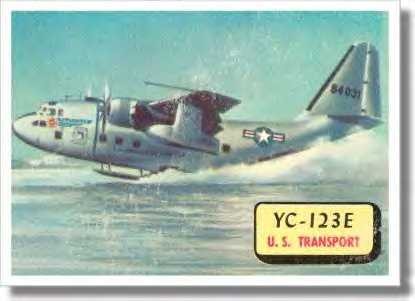
This assumption also plays itself out in the world of military affairs. Contrary to public feel-good assumptions that they are being best protected, the truth is that the chore of national defense has been relegated to existentialist egotists who squabble over roles and missions not how best to serve the common good. The 9/11 attacks should have been a "Pearl Harbor" resulting in whole-scale firing of incompetents and replacement by some mechanism where non-careerist citizens get involved personally in national defense while in uniform so common sense (do what works best all the time regardless of ego) can return to the U.S. military. During WWII, America had to fight across long oceans and since combustion-fuel aircraft cannot fly forever, they need to land and refuel. One solution is to float a runway/airbase for small wheel equipped planes to land on the top; the aircraft carrier. However, this is NOT the only or most efficient solution. Another solution is the seaplane--a fixed-wing aircraft often with a boat hull shape or floats or skis that can land on water to refuel, switch crews, receive maintenance etc. when linked up with a supply ship/submarine. As you will soon see, this common sense solution deemed necessary to meet war-time needs would not last long after the crisis passed and the can-do WW2 "Greatest Generation" draftees were replaced by weak economic and ego-narcissist "lifers".
Large Maritime Patrol Seaplanes can do almost everything: ASW, AsuW, CSAR, SOF, Land Attack

During WWI and WWII, seaplanes were extremely effective at hunting down the enemy's surface ships (AsuW) and diesel-electric submarines (ASW); the U.S. Navy's PBY Catalina amphibious flying boats became the "Black Cat" raiders that struck at Japanese surface convoys with torpedoes, bombs and machine guns. In the Atlantic, the PBY (and later the Sunderland flying boats) in the hands of the British, found the German battleship Bismark and disabled it for later destruction, and forced the U-Boat submarines off the surface so they couldn't run on their diesel engines at higher speeds to attack allied supply convoys. The PBM Mariner could easily land in the open ocean improving upon the PBY and at war's end had routinely taken off with JATO rockets from very rough seas. Instead of the risky Doolittle B-25 land planes-from-aircraft carriers raid which placed 10, 000 men into needless danger, we should have used long-range seaplanes refueled by a few dozens of men to raid the Japanese home islands after Pearl Harbor, delivering enough high explosives to actually materially damage them. In fact, this is EXACTLY what the Japanese did to us to restrike Pearl Harbor but fortunately her Emily seaplanes could not easily land on the open ocean like our PBMs could and needed to use protected waters from uninhabited islands west of Pearl to refuel. Once we realized they were using these islands to refuel to bomb us, we placed forces there and the long-range seaplane bombing stopped.

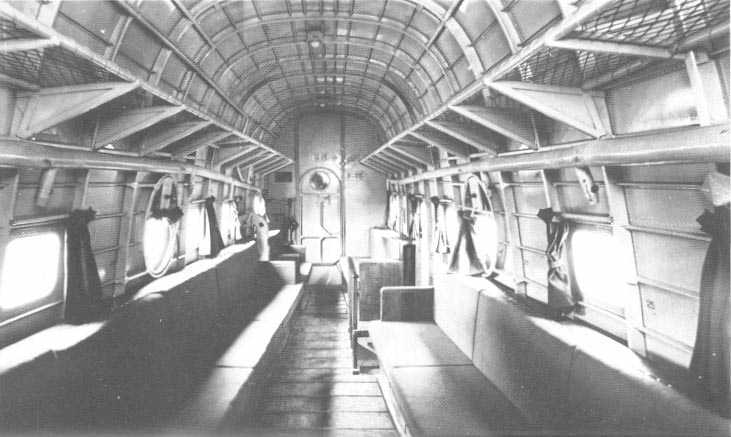

http://marshall.csu.edu.au/Marshalls/html/WWII/SeaPlaneOps.html
Japanese Seaplane Operations in the Marshall Islandsby Dirk H.R. Spennemann
The atolls of Micronesia are ideally suited for seaplane operations. Atolls are rings of coral reef usually with a large and quite calm lagoon in the middle. The islands on the windward side of the reefs provide an ideal plane anchorage on the leeward beach, sheltered from wind and waves. The lagoon is usually clam enough to permit unrestricted landing and take-off of larger flying boats, and so it is not surprising that the lagoons were used as seaplane bases first by civilian and later by military aviation.
Civilian seaplane operations
A reliable long-range seaplane, the Kawanishi H-6K type 97 flying boat ("Mavis") had become available to the Imperial Japanese Navy (IJN) in 1936. The seaplane base were officially operated by a civilian airline, the Dai Nippon Koku K.K. (Greater Japan Airlines) although numerous of its pilots were reserve naval pilots. The first irregular air service flying Yokohama, Saipan and Palau opened in 1935, after successful test flights had been carried out in 1934. The flights became more frequent in 1937 and a regular air route from Yokohama to Saipan (via Belau) was officially opened in December 1938 or April 1939 with hopes for an eventual extension to Papua New Guinea and Australia. The Annual Report of the South Seas Government, the Japanese administration of Micronesia, for the year 1938 states that the airline Dai Nippon Koku Kaisha began and air service connecting Japan with Saipan and Belau. In 1939 Pohnpei and Jaluit were added. During the Pacific War the Dai Nippon Koku K.K. continued its long-distance services, flying scheduled services on its three routes Yokohama-Saipan-Palau-Timor, Saigon-Bangkok and Yokohama-Saipan-Truk-Ponape-Jaluit.
Military development
By 1937 the Imperial Japanese Navy was calling the shots in Micronesia and initiated construction of major improvements in air, sea and land facilities in Micronesia. Seaplane facilities had already been built for the Nan'yő-Cho (South Seas Government) in the late 1930s on several islands of the former Mandated Territory and between 1935 and 1937 the Japanese government spent almost Yen 1,000,000 on further construction of air facilities.
The Japanese air routes in the western Pacific.
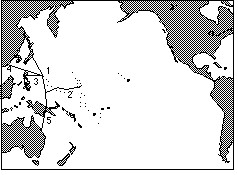
1--Yokohama-Saipan-Palau; 2--Palau- Chuuk-Pohnpei-Jaluit; 3--Saipan-Manila; 4--Saipan-Saigon; 5--Palau-Port Moresby-Australia (planned).
The atolls of the Marshall Islands were ideally suited for seaplane bases. All that was needed to establish a fast seaplane base was to detail a seaplane tender to the atoll, from which the planes could be supplied and serviced. The personnel would sleep in tents on the beach and no permanent structures needed to be erected. The planes would be beached at a sandy beach. Such seaplane bases could be set up almost ad hoc if the situation demanded it. The development of a float plane version of the successful Mitsubishi A-6M Zero fighter meant that advanced fighter bases could be erected ad hoc on any of the atolls of the Eastern Caroline, the Marshall Islands and Kiribati.
A temporary seaplane base could be even set up by the means of one or more supply submarines waiting for the arrival of the flying boats or aircraft. In the Marshall Islands, known seaplane bases with shore facilities were located on Wotje, Wotje Atoll; Ebeye, Kwajalein Atoll; Jabwor, Jaluit Atoll; Djarrit, Majuro Atoll; and Engebi, Enewetak Atoll. Suspected seaplane facilities or temporary seaplane bases may have existed on Rongelap, Mile and Bokak.
Military operations
Long-range seaplanes became available in 1936 with the introduction of the Kawanishi H-6K flying boat and in 1942 with the introduction of the Kawanishi H-8K flying boat. In addition, single-engine float planes were used for anti-submarine patrol. The seaplane base in Jaluit, for example, is known to have harbored in mid-1943 the Mitsubishi A-6M2N's ("Rufe"), a float plane version of the "zero" fighter The aircraft visible on a contemporary photograph possibly represent two air wings and all belong to the 802nd Kokutai (Squadron).
The bulk of the military operations of the seaplanes constituted the flying of long search patrols in a set search triangle, looking for enemy submarines and surface shipping. The planes were equipped with communications and small anti-submarine bombs. Attack operations were less common:
The Japanese attack on Pearl Harbor on December 8th, 1941, was partially launched from bases in the Marshall Islands. Not only came the submarines providing the submarine screen from the base of the 6th submarine fleet in Kwajalein, but also several flying boats taking part in the Pearl Harbor as well as in the raids on the U.S. bases on Wake I., Howland I. and Canton I. were launched from the seaplane bases of the Yokohama Kokutai (later 802nd Kokutai) on Wotje and Jaluit.
Kawanishi flying boats based at Jaluit and Wotje were also used as long-range bombers and on March 4-5, 1942, bombed Oahu, Hawaii, in retaliation of the U.S. carrier strike against the Marshalls in early February 1943. The French Frigate Shoals, some 700 miles northwest of Hawaii Island, were to be used by the Japanese seaplanes as a rendezvous point with submarines carrying fuel and bombs. The French Frigate Shoals had not been used by the Japanese Fleet as a seaplane base in the 1941 carrier attack on Pearl Harbor which began the Pacific War. Having come into classified U.S. Navy Information with the fall of Wake I. on 23 December 1941, however, the Japanese then possibly decided to utilize the atoll. Refueling and arming of two Kawanishi H-8K flying boats took place in the night of 3 March 1942 (U.S. time), which carried out a successful raid on Pearl Harbor the day after.
Another scheduled Japanese rendezvous of three submarines with long-range flying-boats and submarines at French Frigate Shoals had to be called off between May 26th to 31st. The flying-boats were to have reconnoitered Pearl Harbor in preparation for the attack on Midway. Following the Battle of Midway, the U.S. Navy erected a complete Naval Air Station on French Frigate Shoals, which precluded any further Japanese rendezvous.
In September 1942 another major flying boat raid was conducted, attacking the U.S. bases on Funafuti, Tuvalu, and Canton I. It appears that these flying boats either never returned to their home bases in the Marshall Islands or that they were relocated in order to avoid any psychological draw-backs for the 802ND. In addition, flying boats from the Marshall Islands were once more scheduled to bomb Pearl Harbor. As had been the case in March 1942, the French Frigate Shoals were to be used by the Japanese seaplanes as a rendezvous point with a submarine carrying fuel and bombs. However, the Pearl Harbor raid did not eventuate, as the submarine scheduled for a rendezvous with the flying boats found the shoals occupied by a U.S. Naval Air Unit and the rendezvous had to be called off.
As the war progressed, and the U.S. air attacks against the Marshalls become more common, flying boat operations became less frequent, and a number of boats were sunk at their moorings by U.S. fire, such as the three flying boats of Ebeye or the boat off Wotje.
The last Japanese flying boat operations in the Marshall islands occurred in the first and second week of February 1944, when flying boats from the Japanese headquarters in Chuuk flew to the then by-passed bases of Taroa/Maloelap, Wotje and Mile to take off fighter and bomber pilots stranded there.
Bibliographic citation for this document
Spennemann, Dirk H.R. (1992 [2000]) Japanese Sea Plane Operations in the Marshall Islands. Johnstone Centre of Parks, Recreation and Heritage, Charles Sturt University, Albury. URL:
http:/marshall.csu.edu.au/Marshalls/html/WWII/SeaPlaneOps.html
The article first appeared in the Marshall Islands Journal on 25 December 1992
CONTACT:
Dirk H.R. Spennemann, Institute of Land, Water and Society, Charles Sturt University, P.O.Box 789, Albury NSW 2640, Australia. e-mail: dspennemann@csu.edu.au
The Do-24

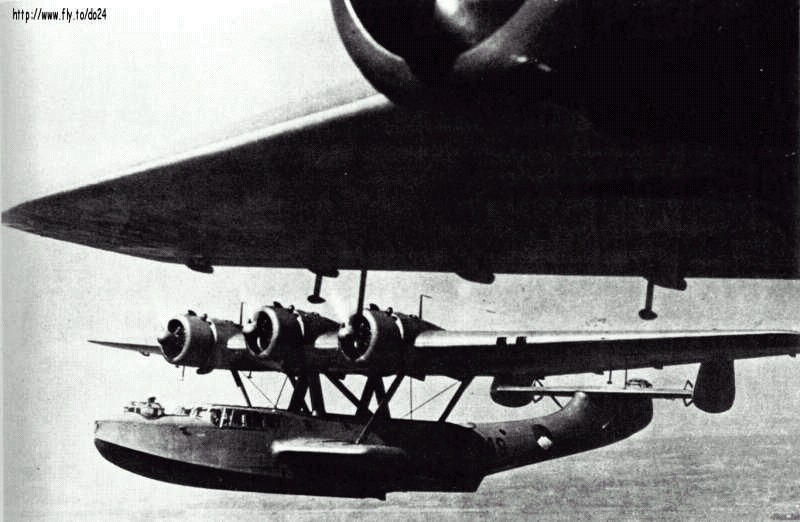
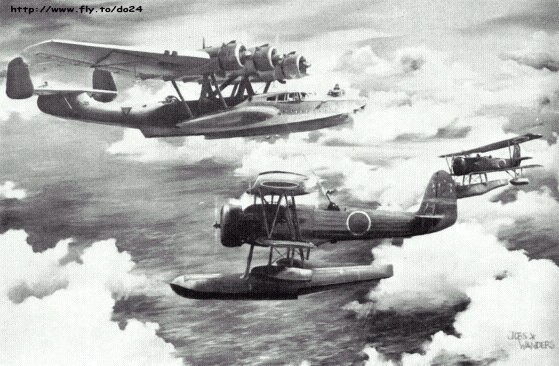
The Japanese Emily and German Do-24 seaplanes were outstanding successes, the later used diesel fueled engines for extremely long endurance and were difficult to catch on fire.
Small seaplanes from tenders, destroyers, cruisers and battleships: Who needs aircraft carriers?
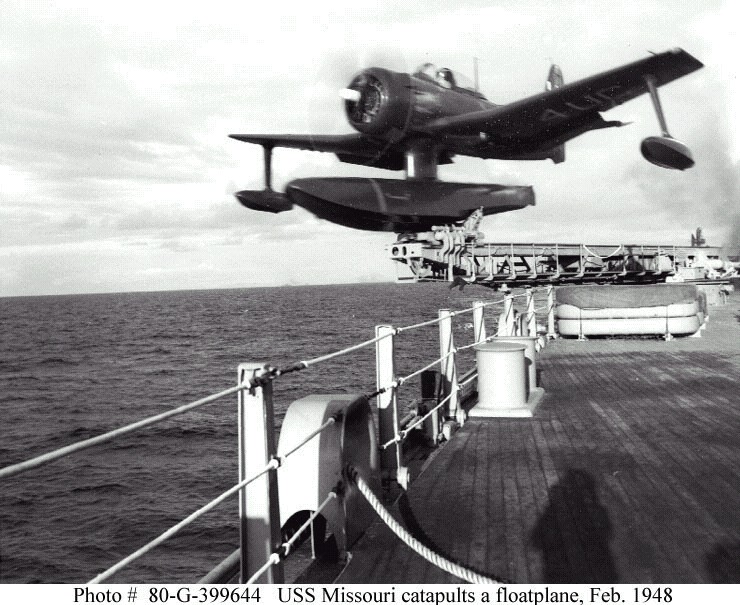
For more details:
The Navy Aircraft Carrier "Airdale" Mafia and/or the rival Submariner Admiral Rickover Rubs out the Seaplane in 1960
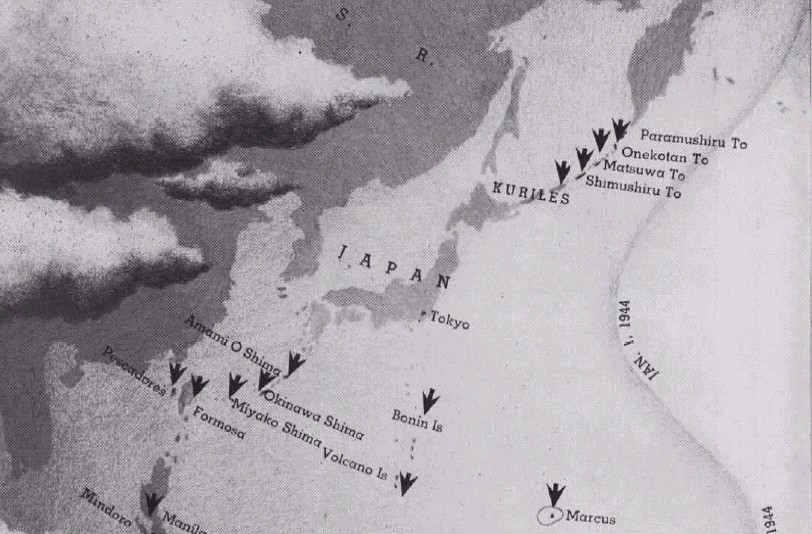
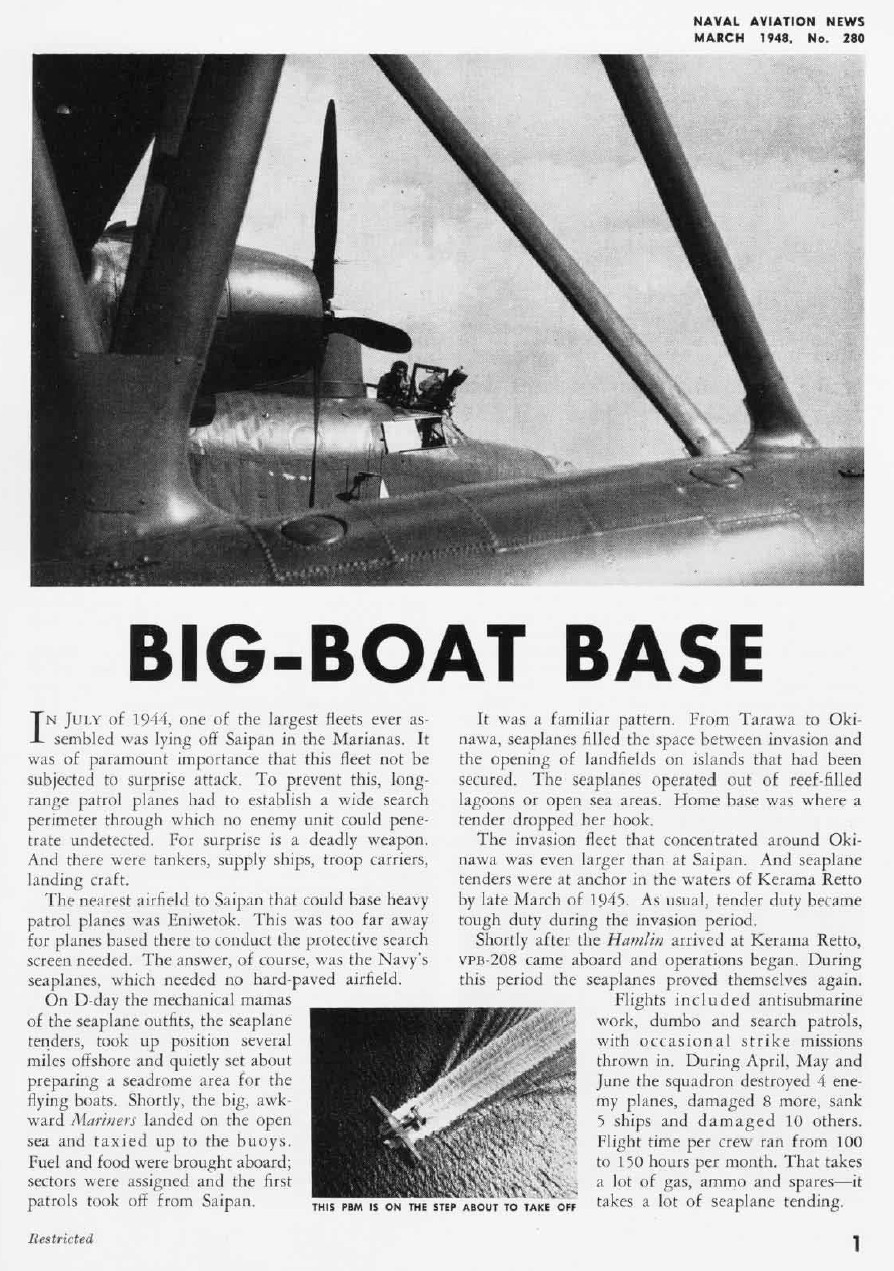
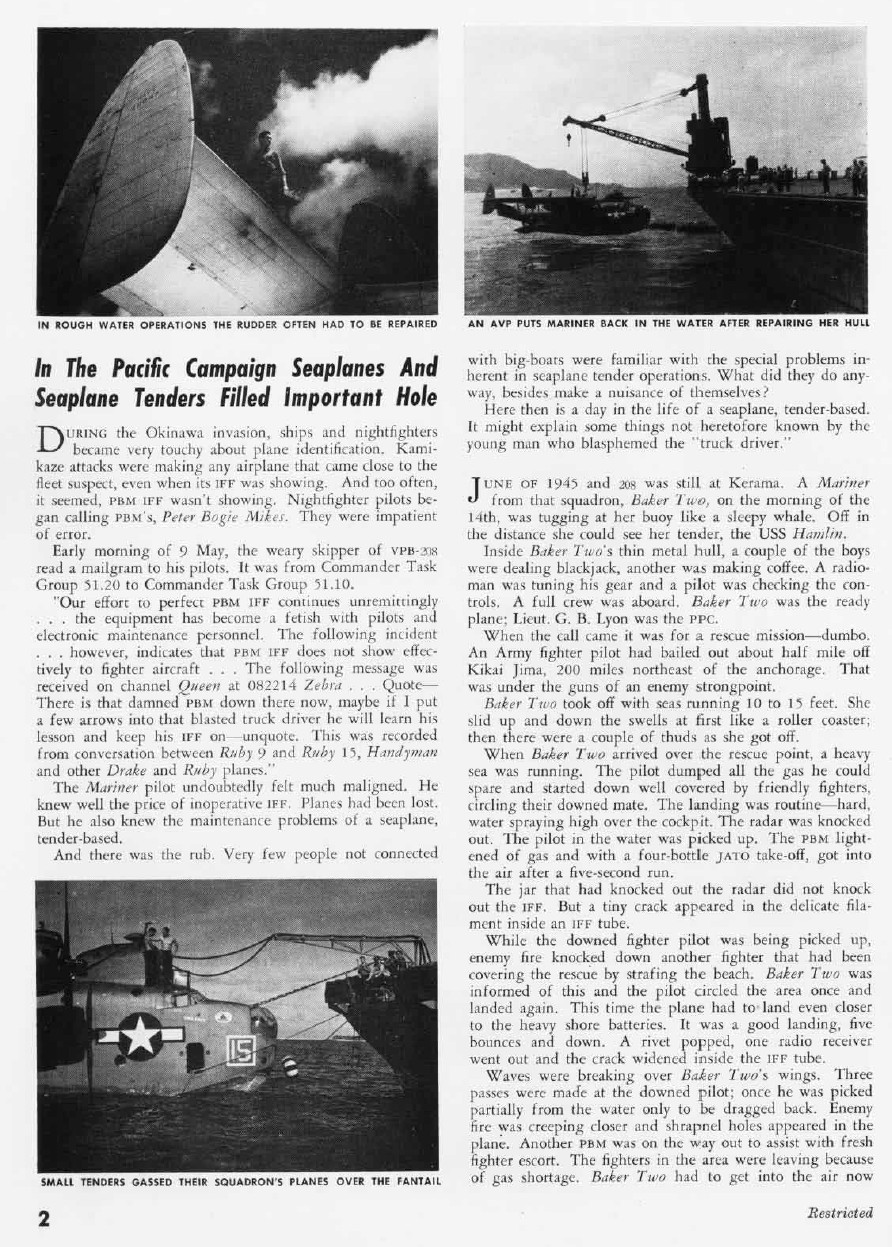
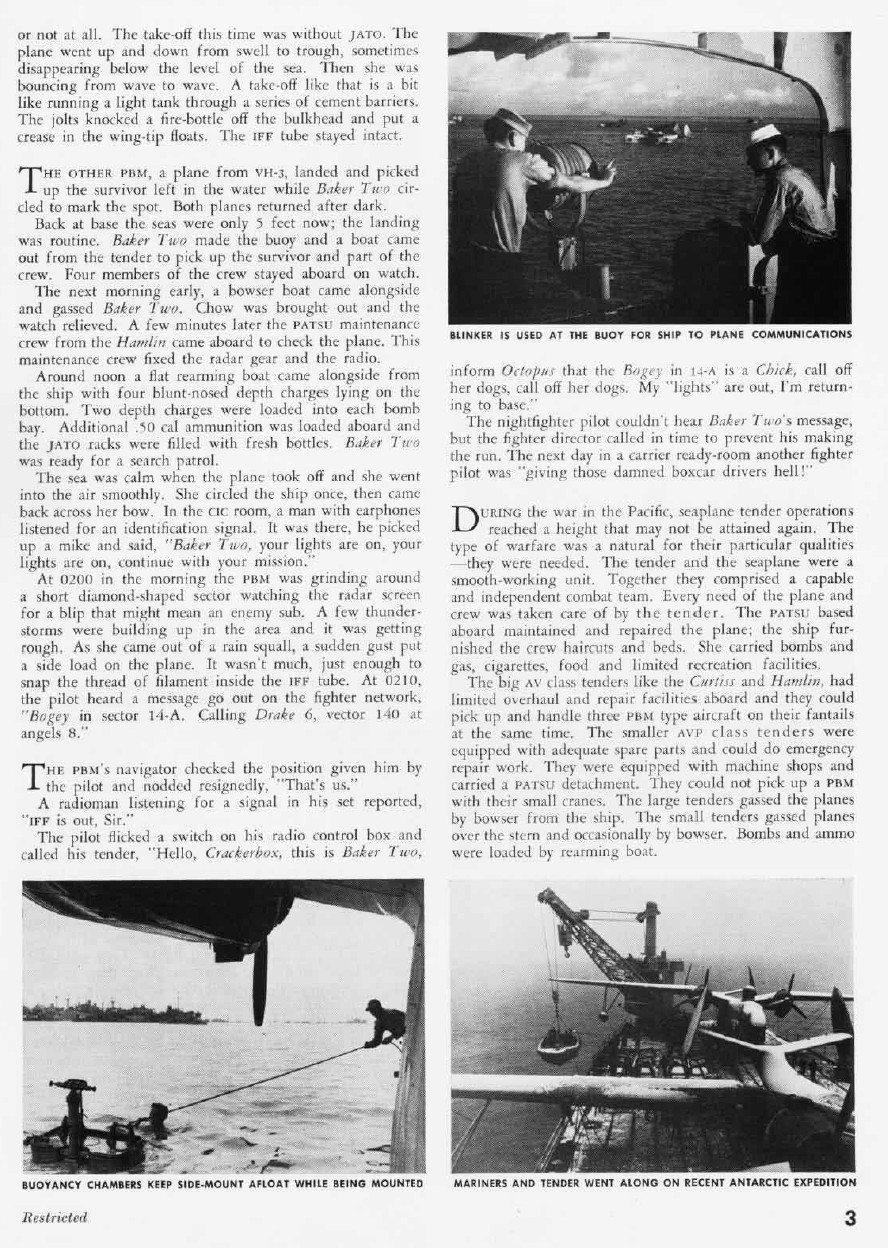
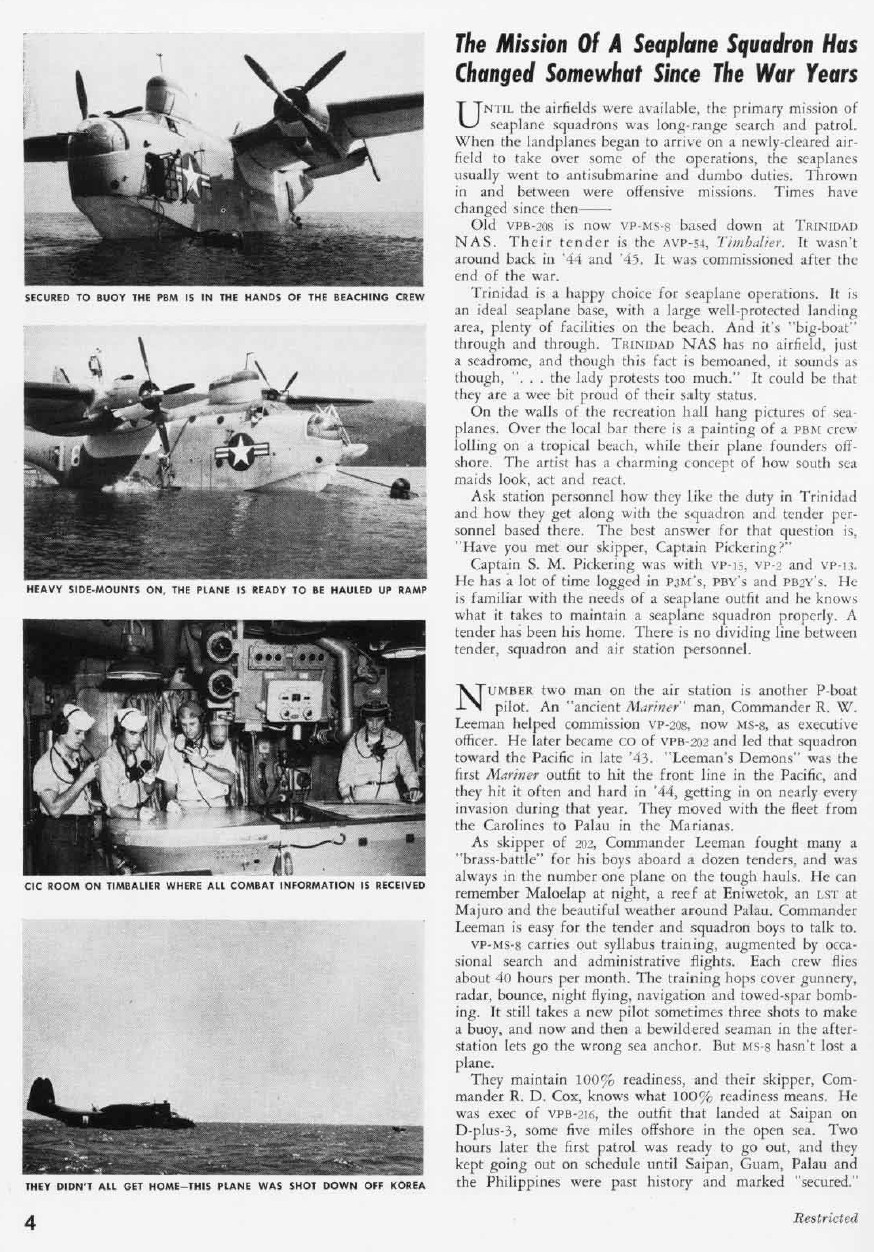
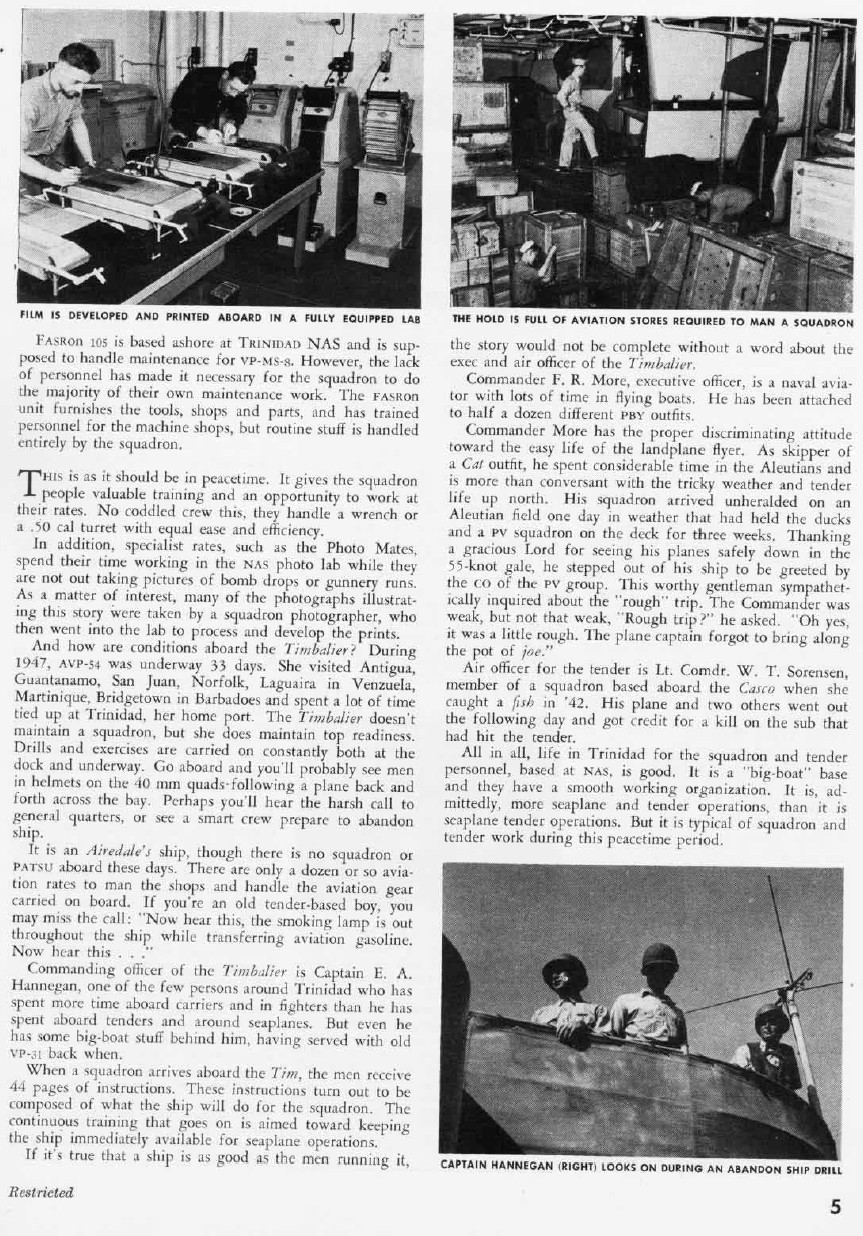
The U.S. Navy's long-range PBY/PBM seaplanes that could land in the ocean and be refueled and re-armed by seaplane tender ships manned by only hundreds of men were used to march up to the Japanese home islands IN ADVANCE of the aircraft carriers that get the credit wrongfully from the USN aircraft mafia propaganda machine. Once seaplanes had advanced to the point where they flew not only as fast but faster than land planes, the USN brass had to squeeze them out of existence lest the American Congress and general public realize that long-range seaplanes and tenders are more tactically and economically efficient than using a handful of bloated aircraft supercarriers and short-range, light payload jet fighter lawn darts. We also have heard an anecdotal report that Admiral Rickover who lead the rival nuclear submarine faction in the Navy went to see a P-6M Seamaster jet seaplane take-off but a technical glitch caused it to not take-off on orders of an overly cautious civilian technician in charge. Fuming in his limousine, Rickover drove back from Maryland to presumably his Washington D.C. office and the Seamaster program was cancelled the next day. Whether Rickover called his Congressional allies to stab the Seamaster in the back is not clear, but its a possibility.
The point here is that in a large monolithic bureaucracy there can ONLY BE ONE EGO PLATFORM OR IDEA, all other differing things must remain subordinate and act in a supporting role. If they start to take a starring role, they will be squashed. If America is to survive to see the 21st Century, we need a military where VITAL FUNCTIONAL AREAS can appeal directly to Congress for funding and not be strangled at the top by monolithic egobureaucracies so we can have ALL THE DIVERSIFIED CAPABILITIES WE NEED.
MATS: Seaplane transports triumphant; Martin says no to the Kaiser, then DoD reorganization under USAF-dominated MATS damns them

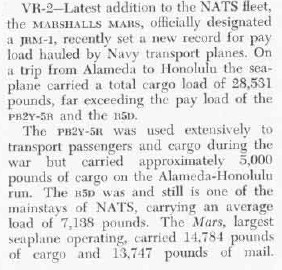

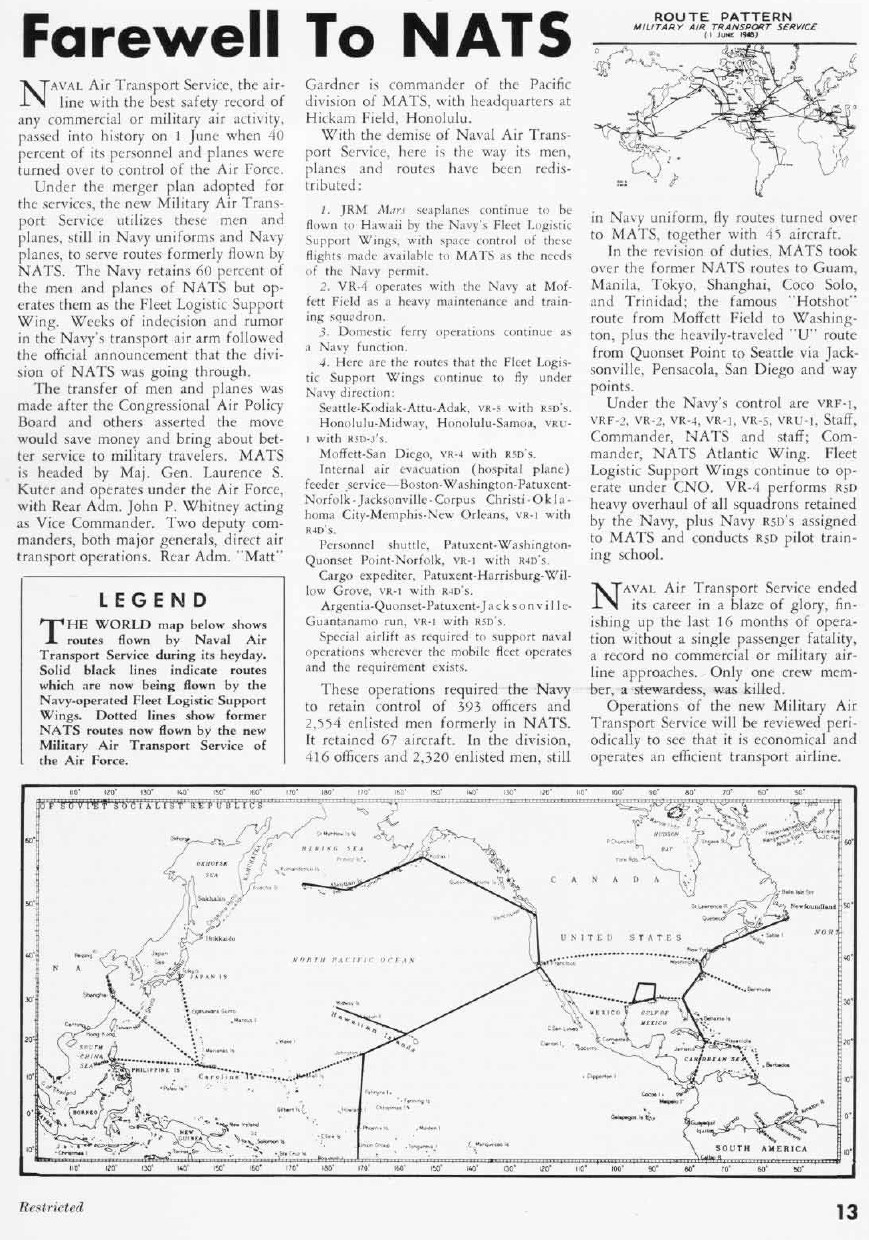
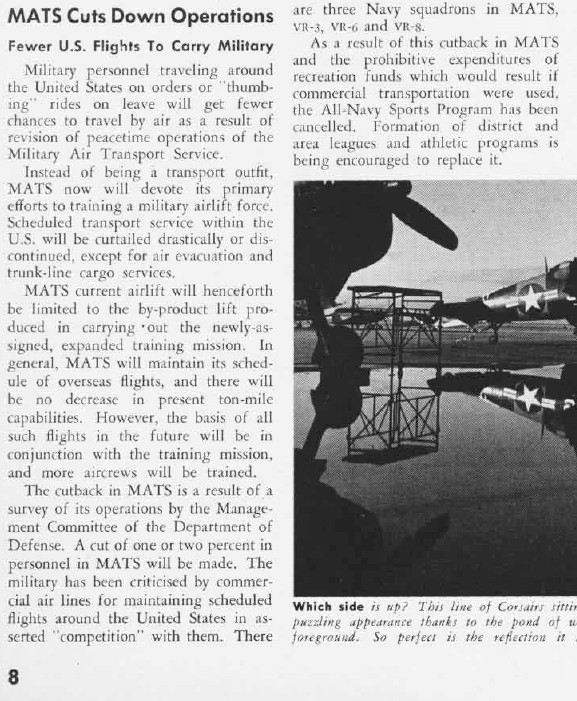
As WW2 raged, America was thrown into the fight by the FDR-instigated Pearl Harbor attacks. Insulated by two oceans, these strategic moats had to be crossed to GET TO THE FIGHT in Europe and the Pacific areas. Genius industrialist Harry Kaiser came up with the modular, mass-produced "Liberty ship" which he literally could make 1 a day! Thousands of Liberty ships would transport infantry, tanks, artillery pieces, dis-assembled aircraft, ammunition and supplies to swarm and smother the Germans and Japanese until their nation-state capital cities were taken and the war ended. To protect these ships in convoy from German U-Boat and Japanese submarine attacks, FDR had Kaiser build almost one hundred cargo-ship based escort or "jeep" aircraft carriers with hundreds of naval (sea) planes to scour the oceans. Here a critical mistake was made by the premier seaplane builder, Glenn Martin.
The Glenn L. Martin Maryland Aviation Museumwww.marylandaviationmuseum.org/history/martin_aircraft/14_mars.html
Martin Models 170, 193 and 199
XPB2M-1, JRM-1 To JRM-3, Mars Flying Boats
Variants/SpecificationsIn some respects the PBM represented an interruption in Martin's work on huge four-engine flying boats. These had become something of an obsession with the firm's founder and president. In 1938 the Navy ordered a single prototype Martin Model 170 as an experimental patrol bomber, designated XPB2M-1. This was to be the Martin Mars, a 140,000-pound behemoth that was the largest plane in the U.S. military inventory until the arrival of the B-36 intercontinental bomber in 1947. The Mars was originally conceived as a "sky battleship" or "flying Dreadnought," armed with multiple gun turrets, capable of flying long distances with huge bombloads (and marine paratroopers as well). In speeches and articles, Glenn Martin predicted that a single Mars could capture an enemy island or "totally destroy" a rail center or shipyard. A squadron of them, he wrote, could "devastate Tokyo in one trip."
The XPB2M-1 was accordingly treated like a warship. Its keel was ceremoniously laid on August 20, 1940, with Glenn Martin driving the first rivet. Its launching into Dark Head Creek on November 5, 1941, was stern-first, after a bottle of champagne had been duly smashed over its bow. The plane's interior was laid out with separate mess rooms, berths, and washrooms for officers and enlisted men. Its commander had a private stateroom and issued his orders from a desk behind the pilots' seats. A huge bomb-bay, located in the hull underneath the wings, contained racks capable of holding five 1,000-pound bombs each. When it came time to drop them these could slide out on either side along the lower edge of the wing.
Initial taxiing tests in Middle River came to an abrupt end on the Friday before Pearl Harbor when one of the giant laminated-wood propellers threw a blade. It just missed the Martin flight engineer inside the hull and started a fire in one of the huge Wright R-3350 engines. The stricken sky battleship had to be towed closer to shore to allow firemen to put out the blaze. When the smoke cleared serious damage to the starboard wing and number-three engine nacelle were apparent. Repairs took more than six months, by which time the plane's mission had undergone a complete re-evaluation.
Pearl Harbor showed that fast carrier planes made very effective bombers indeed, while German U-boats turned the Atlantic coast into "Torpedo Alley." Thoughts naturally turned to a "sky freighter" as an alternative way to ship supplies to Britain and other battlefronts, invulnerable to torpedoes. The industrialist Henry J. Kaiser suggested that, given Martin's blueprints for the Mars, he could quickly build hundreds of the planes in his west-coast shipyards. Martin's response was ambivalent. Although the company issued calculations suggesting that building the Mars in quantity would be more cost-effective than Liberty ships, Glenn Martin was not inclined to share his prize plane with another manufacturer. Kaiser joined forces instead with Howard Hughes; this was the origin of Hughes' 400,000-pound "Spruce Goose." Like Hughes, what Martin really wanted was government support for an even larger flying boat. Plans for the 250,000-pound Model 163, projected back in 1937, were dusted off and modernized. Building five hundred six-engine Model 193's could win the war, declared Glenn Martin, and company ads frequently depicted it as a postwar airliner. Meanwhile the Navy redesignated the original Mars as a transport, XPB2M-1R, and Martin began to remove its turrets and bombing equipment.
Long before either Mars transports or the Model 193 could have been ready, the tide had turned in the Battle of the Atlantic. The Mars was sent to the Pacific instead, where it built an impressive record between 1943 and 1945, carrying cargoes of up to 34,811 pounds. Particularly impressive was the plane's ability to carry ten tons of cargo on the critical California to Hawaii route.
In January 1945 the Navy ordered twenty more Mars transports, now designated JRM-1. In comparison to the original, their hulls were to be six feet longer and the split PBM-style tail replaced by a single 44-foot vertical fin. Fewer internal bulkheads and an overhead hoist would assist cargo-handling. Maximum take-off weight grew to 148,500 pounds. Recalling the China Clippers a decade before, the first JRM-1 was christened the "Hawaii Mars" in July 1945. It crashed just two weeks later in a landing accident on Chesapeake Bay. Four more JRM-1's were completed in 1945, but, in the wake of V-J Day, the Navy order was cut to six.
Peace allowed Martin pursue the long-cherished goal of selling giant airliners. The Mars was offered in several commercial versions for passengers and cargo. Re-engined with massive four-row Pratt and Whitney R-4360 Wasp Majors, the largest piston engines made, Model 170-21A offered transatlantic range with 58 sleeper or 79 coach seats. Model 170-24A could seat 105 for shorter ranges. But the construction of so many long runways during the war eliminated one of the flying boat's principal advantages. Martin recognized this and began work on a 145,000-pound landplane using the same engines and wings as the JRM-1; the Model 199 was to have a floor level no higher than that of a truck. Other four-engine airliners were already on the scene, however. There were no airline purchasers for either the 170 or the 199.
The Navy did purchase its sixth and last Mars with Wasp Major engines, which enabled the single JRM-2 to carry an extra 18,000 pounds of cargo on the San Francisco-to-Hawaii run. The four earlier planes were eventually re-engined with Wasp Majors as well and designated JRM-3's. All five served in the Pacific, carrying military personnel, Korean-war wounded, blood plasma, and other priority cargo over the same routes as were once flown by the glamorous clippers. Like them, they were duly christened for Pacific destinations: Philippine, Marianas, Marshall, a second Hawaii, and Caroline.
A fire destroyed the Marshall Mars in 1950; the other four JRM's served the Navy until 1956. They were then sold as surplus to Forest Industries Flying Tankers Limited, a Canadian firm, which uses them to drop 60,000-pound loads of water and foam on forest fires. The Marianas Mars crashed in an accident in 1961, and the Caroline Mars was destroyed in a hurricane a year later - but as they approached age 40 both the Philippine and Hawaii Mars were still flying.
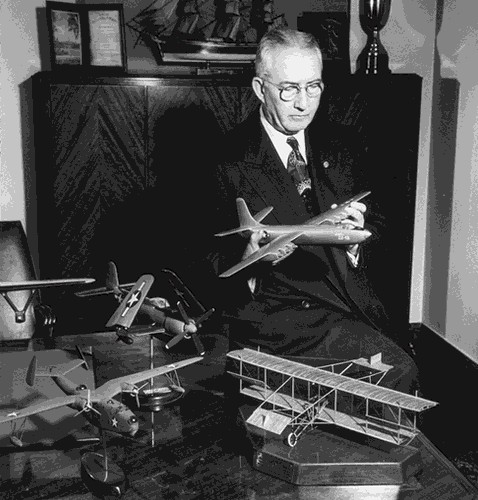
Glenn Martin: a genius but made a fatal mistake for seaplane progress in not sharing Mars seaplane production with Kaiser in WW2
Kaiser asked Martin if he could mass-produce his huge Mars seaplanes as TRANSPORTS so we could have FLYING LIBERTY SHIPS in essence, we could have moved fighting men and fighting tanks OVER THE WATER at 200 mph and not been subject to submarine or sitting-duck surface ship aircraft attacks. As great as the Liberty ships were, they were very SLOW and we only got away with the troopship mentality in WW2 because the enemy's high explosive weapons were unguided so their firers had to get into line-of-sight firing positions which we could prevent by smothering them with LTA blimp, land and sea patrol planes, small seaplane and jeep carrier aircraft and ASW escort ships. From 1943, onward we had defeated the early-technology German diesel-electric U-Boats that needed to run on the surface to recharge their batteries so they fielded guided bombs and missiles that in one instance sank a troopship packed with over a thousand American Soldiers. This is a foretaste of what will happen to our stupid marines packed by the thousands in amphibious ships today in a major nation-state war.
So we knew by the end of WW2 that packing men into ships by the thousands was suicide and the atomic bomb should have put an end to it, but didn't. Despite the leadership of marine General Geiger's Board that the SEAPLANE become the primary way to move marines, unimaginative traditionalist commandant Vandergrift opted instead to place slow, short-range helicopters on ships when this would not even come close to the dispersal needed to avoid even high explosive attack annihilation much less nuclear strikes. The relive-Iwo Jima cult had begun that places our nation's national security at risk.
And this is the whole point about this.
Human beings rarely put their entire minds into war, and this is a good thing. However, when we do think about the common defense, we need to arrive at the BEST solutions and implement them so the NEXT TIME we are at war, we will be as ready as possible judging from the last war. Its a start. Instead, we have emulated the worst aspects of WW2 and only gotten away with it because no one has challenged this stupidity at sea as of yet as we proceeded to fight little wars against little nation state and sub-national group foes.
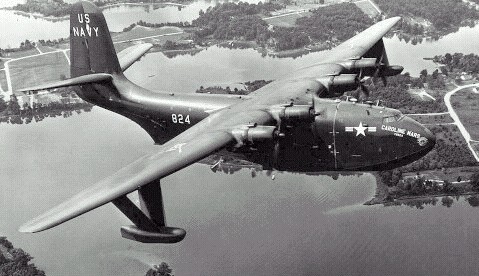
WW2 was a golden opportunity to showcase what HUNDREDS OF LARGE SEAPLANE TRANPORTS COULD DO MOVING GROUND COMBAT FORCES MUCH FASTER AND SAFER THAN BY SLOW AND VULNERABLE SURFACE SHIPS.
But Glenn Martin said "NO" to Harry Kaiser.
I don't know if it was corporate greed or self-interest but the Martin Aircraft company was maxed-out building seaplanes for the navy and B-26 medium bombers for the Army. Having Kaiser build hundreds even thousands of Mars seaplane transports would have SHOWN THE CONCEPT OF AIR-MECHING GROUND FORCES ON A LARGE-SCALE and at the very least shown THERE INDEED WAS A BETTER WAY THAN PACKING MEN BY THE THOUSANDS IN SURFACE SHIPS.


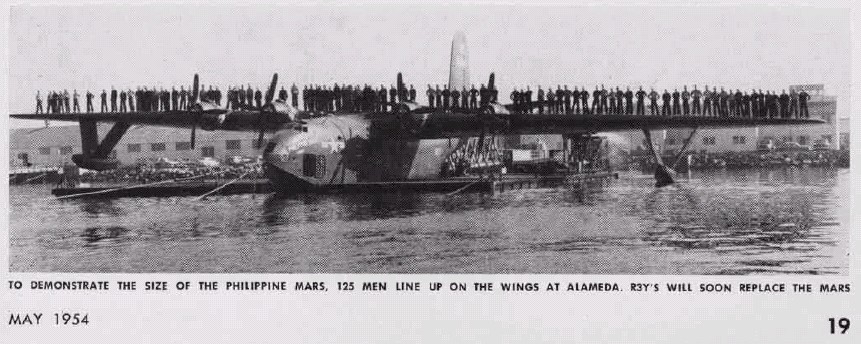
As it panned out, only 6; that's right 1-2-3-4-5-6...Mars seaplane transports were built, and in just 10 short years the brilliant Martin would be dead and 5 years after that his company gave up the ghost and let the assholes in the Navy kill 60 years of seaplane development just when it had triumphed over land plane design. If Martin wanted to protect his seaplane business with the U.S. military he should have carved out a larger functional niche with the help of Harry Kaiser mass-production so his concept would endure and not be swallowed up and spit out by the corrupt post-war military-industrial-congressional-think-tank complex of narcissistic egomaniacs and false war formula snake oil salesmen.
As it was, the brilliant Mars seaplanes--all 6 of them went into service in the Pacific under the Naval Air Transport Service (NATS) And did amazing feats of transporting men from the west coast to the far flung island bases. However, all of this was done behind the trace of assaulting ground forces and not strategically, operationally or tactically to project forces in COMBAT as having hundreds and even thousands of seaplanes could have enabled.

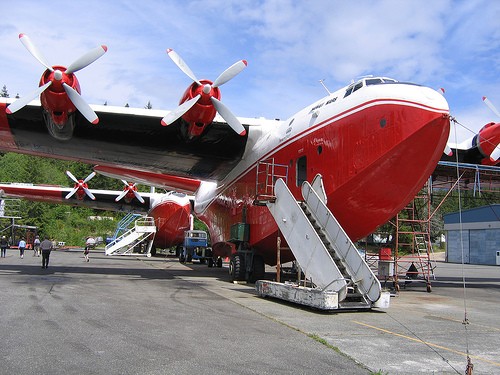
Two of the fabulous Mars seaplanes STILL FLY TODAY AS MASSIVE FIREFIGHTING WATER BOMBERS. These mighty seaplanes survive and thrive because their large wings make them extremely efficient at moving massive payloads, a secret the Navy learned by operating them under NATS in WW2.
At the end of WW2, a disastrous reorganization took place giving us the current FUBAR Department of Defense (DoD). The goal to prevent a nuclear "Pearl Harbor" by having a SMALL military and covert force always in action was a good one, but the plan to DOWNSIZE FUNCTIONS INTO CENTRALIZED BUREAUCRACIES was and still is a fatal recipe for important capabilities and platforms to be squeezed out of existence by monolithic ego empire builders. NATS was merged into the USAF land-plane mentality dominated MATS against the better Navy wisdom of how best to support naval forces. At first, the USAF tolerated the Mars seaplanes as the Navy bureaucracy would have to fund them and any replacements. Meanwhile, they improved their land transport plane designs with t-tails and rear ramps, turboprops and turbojets and turbofan engines embodied today by the marvelous C-17 Globemaster III.
However, in WAR you need over-lapping capabilities, this costs more money and cheapo DoD budget bean counters and your own service's ruling mafia wanting supercarriers are not going to support seaplane transports at the expense of their ego or cash cows when they think they can get by with centralized less in peacetime. As great as the USAF's turboprop C-130s and C-17s are, they cannot land on the water. The C-130 could if floats or Pantobase skis were attached but even the Navy SPECWAR community hasn't taken advantage of this possibility. They can airland or airdrop, and the latter can deliver into the water but requires parachutes and difficult recovery.

Under MATS, the Mars seaplanes were still so damn efficient they continued in use until 1960 when the Navy brass did their Stalinist purge of all seaplanes once they realized "the gig was up" with the advent of Martin's P-6M Seamaster jet seaplane patrol bomber. New generations of jet seaplane transports would also threaten the pork of having hundreds of BS vulnerable surface amphibious ships to sardine pack marines inside as part of the relive-Iwo Jima cult. The Navy wanted tactical and economic inefficiency because it pays in greater budget dollars from Congress. So the mighty Mars seaplanes were sold in 1960 to a smart Canadian forest fire fighter and him and these planes have done a marvelous job saving lives and forests for the people of North America.
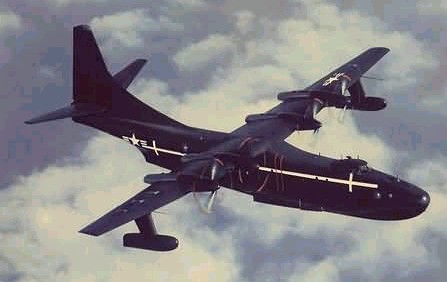
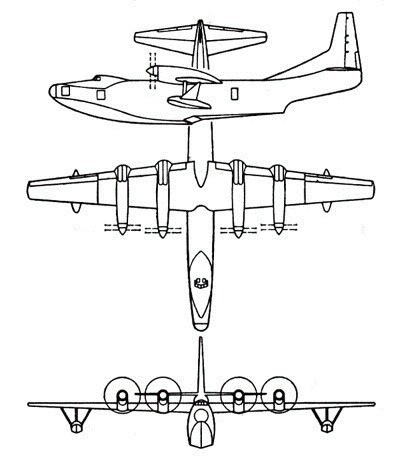
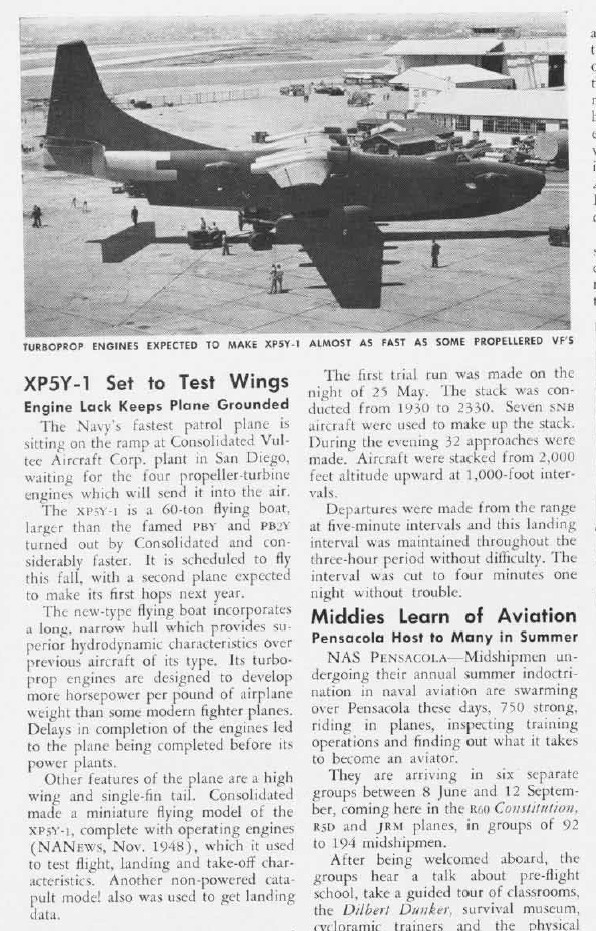

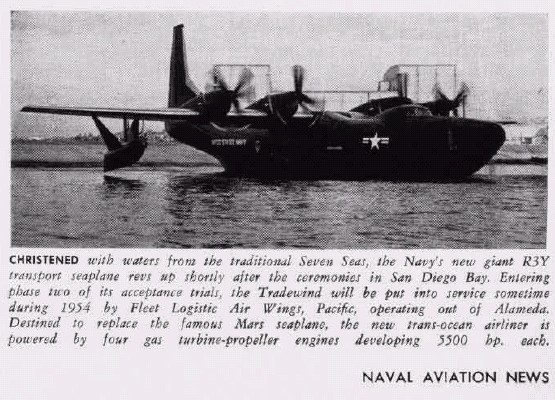
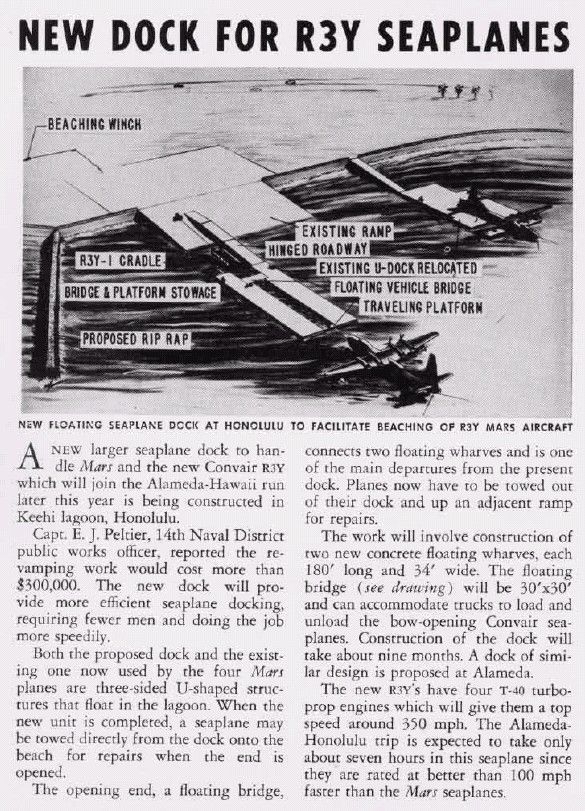
There was an effort to replace the Mars seaplane transports with the R3Y Tradewind which would fly at 400 mph using contra-rotating props and turbine engines solving the speed problem once and for all. The Tradewind flew faster than all of the USAF's C-130s and only does today's C-130J with 6-bladed props can reach 400 mph sustained speeds. The problem with sustaining a niche in a monolithic, hostile ego-bureaucracy is that you cannot afford ANY mistakes. If you make one or a few you give your egobureaucratic opponents the leverage they need to rub you out of existence under the lie that they are saving money when really they are protecting their BS practice and rice bowl. Whenever you break new ground and do something new in order to make PROGRESS, you are going to have some problems. As long as they are FIXABLE you should have some perseverance and fix them to get the best result.

Americans for some strange reason have yet to field a reliable contraprop turbine engine package. The Allison T-40s damned not only the R3Y Tradewind seaplane transport they damned the SkyShark prop attack plane, the AJ-2 Savage tanker/bomber and the POGO tail-sitter small ship air defense fighter. The U.S. Navy of all the services desperately needs COMPACT but powerful prop planes to operate at sea from ships. They need the fuel miserly aspects of prop planes to range out and cover vast expanses of the ocean to find out the enemy before he finds them in their vulnerable surface ships and keep our oil tankers and container ship commerce intact to reach their destinations.
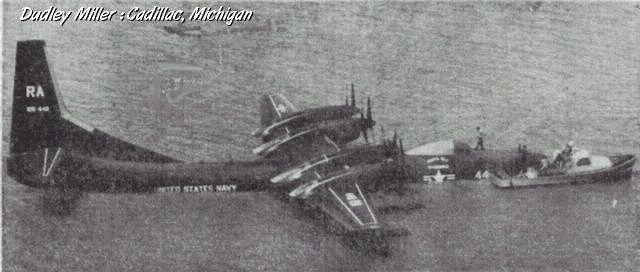
However, when the Allison T-40 contraprop failed, the jet fighter pilot airdales had the excuse they need to rub out their rivals in prop planes, placing today the entire viability of our dozen supercarriers and our ability to control the seas in question. We also lost our SkyRaider 300 mph prop attack plane when we didn't get a new contraprop version that didn't have pilot-killing torque and could fly at 500 mph to enter/exist the battlefield to render close air support for our ground troops that actually can see the hiding enemy below as we found out the hard way in Korea that pilots in fast jets can't see a camouflaged enemy.
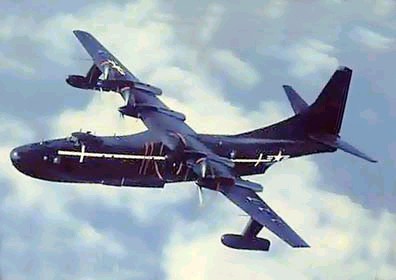
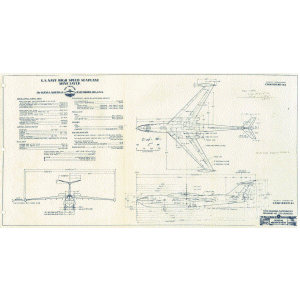
Scott Lowther's Amazing Web Site
What should have happened if non-egotistical adults were in charge of the USN, is that both the Tradewind and SkyShark programs should have been SUSPENDED---not cancelled--until such time that working contraprops were developed or FOUND. Here is the disgusting part.
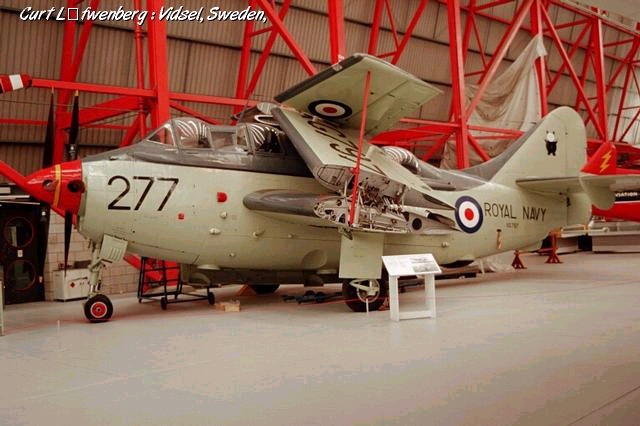
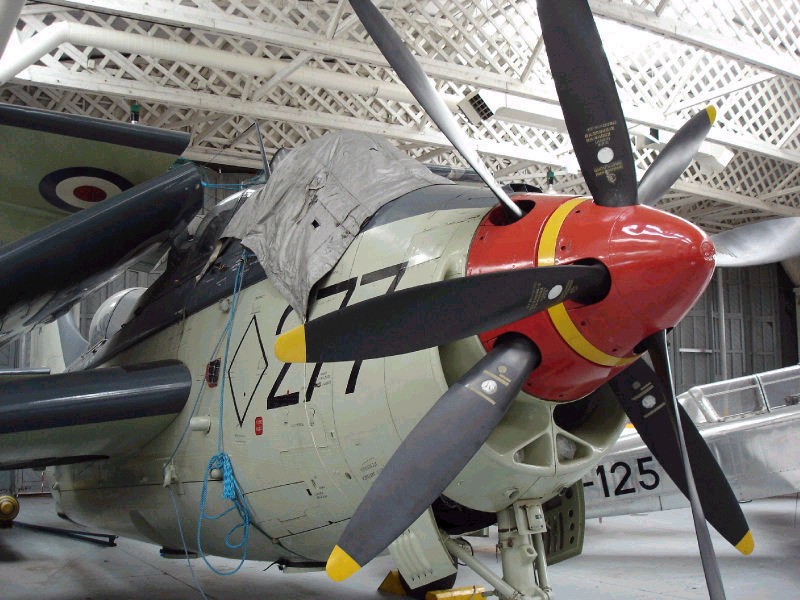
In the pre-internet era, no one seems to have bothered to ASK the British OUR ALLIES for help in the form of their Mamba contraprop engines being used SUCCESSFULLY at the time by their ugly duckling but damn effective Fairey Gannet carrier-based ASW and AWE plane. The Mamba would have made the SkyShark and the Tradewind fly successfully. Problems solved and important capabilities retained and improved upon.
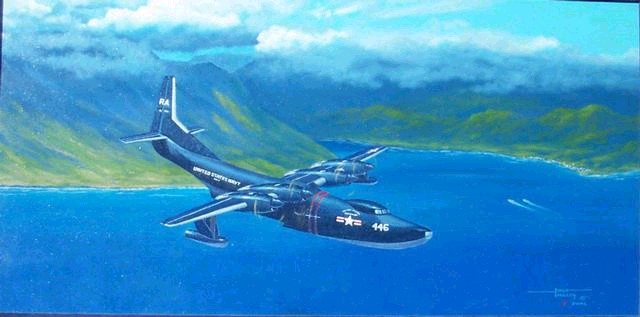
Now some may say this is all moot because they think today's USAF fast fighter-bombers and airlifters are "good enough". Not true as we have already explained. We have an effective U.S. Army Airborne that can fly anywhere in the world thanks to USAF land-based transport planes; its too light and needs M113 Gavin and other light tanks to do Airborne warfare (3D maneuver) but the default of not having large seaplane transports means we have a fucked-up marine corps wanting to relive Iwo Jima with faulty helicopters and faulty amtracks. You could rightfully conclude that the USMC and the Navy are getting what they deserve for their own egocentricity and stupidity, however the American taxpayer needs an effective sea military service that compliments air and land power projection not ego self-services and shouldn't fund these WW2 re-enactment clubs that are bent on self-validation through "heroic" suicides in war.
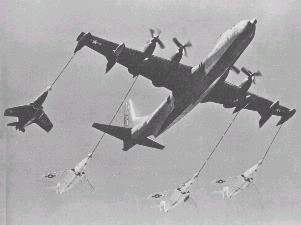
The narrow and selfish mindedness of the aircraft carrier mafia is apparent as one of the missions of the R3Y Tradewind WAS TO HELP THEM FLY THEIR SEXY FIGHTER-BOMBER LAWN DARTS REACH LONG RANGE TARGETS WITH IN-FLIGHT REFUELING as the picture above shows.


The USN could have had its own strategic fleet of Tradewind seaplane tankers to extend the range of their carrier based fighters and maritime patrol planes both P-3 Orions and P-6M Seamasters instead of HAVING TO BEG FOR TANKER SUPPORT FROM THE USAF AS IT DOES TODAY. They were and still are a penny-wise and a pound foolish. Seaplane tankers could land on the water, gulp fuel from a HUGE oil tanker full of fuel and stay overhead to refuel both USAF and Navy and Army planes that can't land on the water. Go ask the Israelis who need to strike Iran's nuclear facilities if they could use some seaplane tankers today to enable their fighter-bombers to reach.
Safety, anyone? Seaplanes are the safest way to cross oceans: another unintended consequence of the Navy seaplane back-stab

Whether you like it or not, whether you want to admit it or not, but the pilots-engines-airfames (PEA) combination of heavier-than-air (HTA) flight WILL fail from time to time. Do you want to admit to this and be prepared with a "Plan B" and live or live in Egypt (DENIAL) and die? Sadly flying airplanes over planet earth fills up the heads of many with excessive Nimrod-Tower-of-Babelesque vertical pride, and this hubris refuses top admit so HORIZONTAL humility is needed so when PEA fails we can float in the water and survive as Noah's family did in the fabulous ark.
The first HTA planes to offer commercial passenger service were Sikorsky's Pan Am clipper seaplanes in the 1930s.

If something should go wrong and couldn't keep flying, you could land in the water and Taxi on water to safety or await rescue in a dry state and not die from exposure or sharks. Pan Am's clipper seaplanes added to MATS seaplane delivery capabilities during WW2.
However, passengers want to get to point B from A quickly and thinner wing and fuselage jets at 600 mph beat the 200 mph speeds of fat wing and boat hull seaplanes. The problem is that if you have to crash land in the water (ditch) in a tube and wing land plane not prepared to even float you ARE going into the water and WILL die of exposure and sharks unless rescued promptly. Current aviation conventional think is that if we keep at PEA we will eliminate all crash landings as Australian Quantas airlines and the USAF's C-17 have done. This is a false and unrealistic notion. It lacks basic humility that we are in a battle against the earth (TBATE) and that even the BEST PEA approach may fail in the event of encountering bad weather. Its a known fact that JETS DO NOT CONTINUE TO FLY IN SEVERE THUNDERRSORMS AND HURRICANES, this is why hurricane hunter aircraft are PROP PLANE C-130s. Had the U.S. Navy done its damn job and continued with seaplane development we would have safer seaplane airliners probably derived from the P-6M Seamaster flying as fast if not faster than land based airliner jets.
You may employ the c'est la vie (it is life) or c'est la guerre (it is war) excuses and say YOU are willing to accept people dying with status quo tube and wing landplanes. That is fucking downright fuck-you neighborly isn't it? "Too bad for you if you die, I'm going to take my chances that when the statistics fall I'm not in the plane that crashes". This is a violation of the basic tenet of human co-operative morality---the Golden Rule---which is to DO UNTO OTHERS AS YOU WOULDS HAVE THEM DO UNTO YOU. If you don't want to crash and burn or drown in a plane THEN GET OFF YOUR ASS AND MAKE PLANES SAFER SO YOUR NEIGHBOR DOESN'T HAVE TO, EITHER. You may not like my use of profanity to express justifiably anger at evil practices, but what is more profane, some words that make you UNCOMFORTABLE or MAKING PEOPLE ORPHANS AND WIDOWERS AND WIDOWS? What's the evil here? Using a word that starts with the letter F or MURDERING PEOPLE? If the unpleasant sounding words will save lives then so be it, since reason and logic without the MORALITY TO CONDEMN BULLSHIT FAIL MISERABLY TO CHANGE PEOPLE'S NEGATIVE ATTITUDES AND BEHAVIORS.
Another aspect of mass murder created by a lack of jet seaplane airliners is that the fools at AirBus are limited by land runways seeking to pack like sardines over 600 people in their double-decker bus air clone A380 tube & wing deathtrap. If we want LARGER AIRLINERS TO HOUSE MORE PASSENGERS that require longer take-off runs the safe way to do this is by taking off and landing from the WATER where you have limitless distances to do so. If you are on fire, or have other emergencies landing on water is safer than crash landing on land which doesn't have fire-dampening effects.
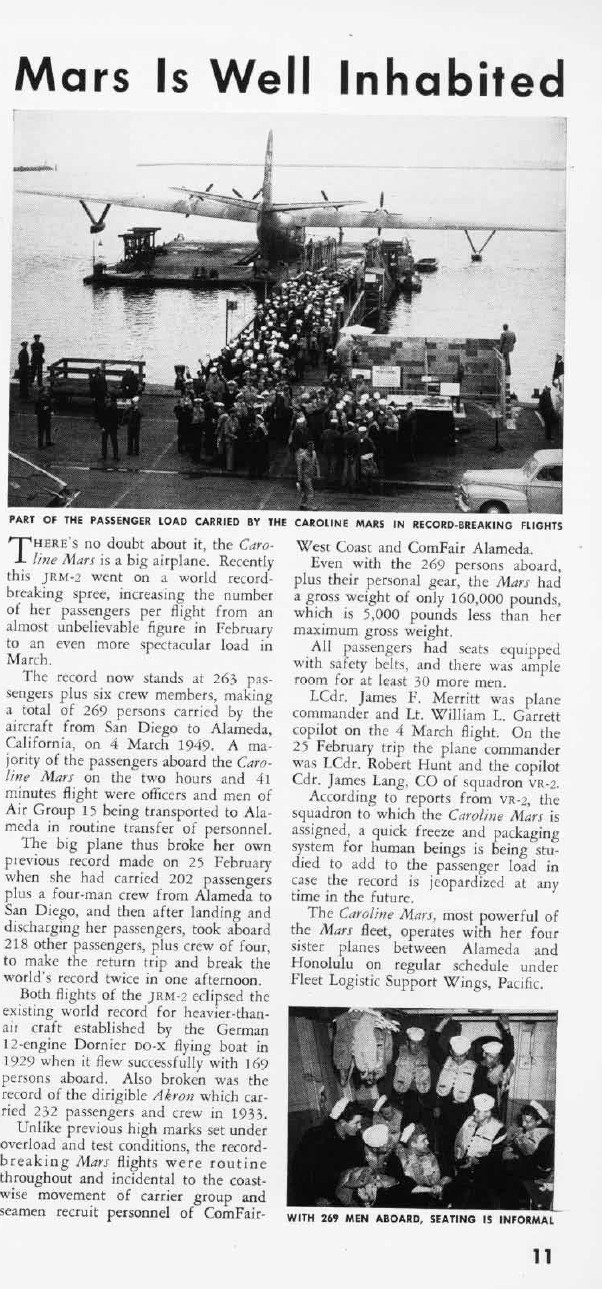
FYI, the USN Mars seaplane service from 1942-1960 didn't LOSE A SINGLE PERSON, EVER! No fatalities. Chalk this example up with Quantas and the USAF's C-17 fleet into the halls of successes we need to emulate.
SOF: seaplanes and special operations go hand-in-hand IF you are willing to do what works best
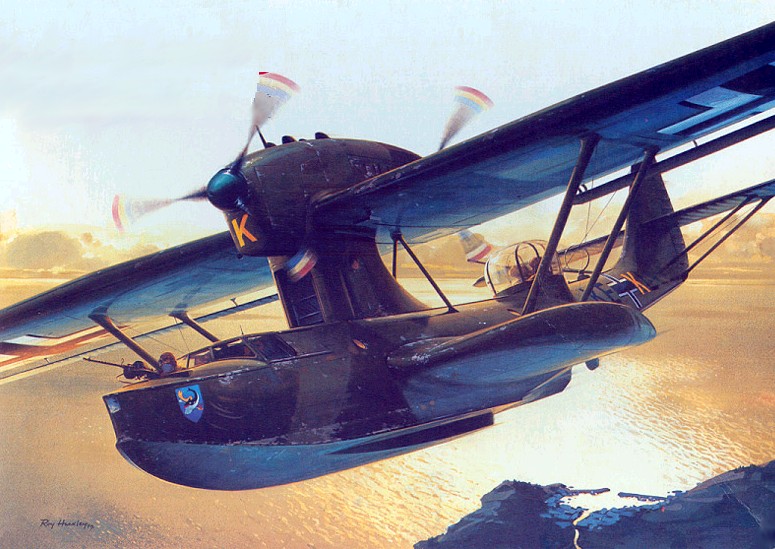
In 1938, the Germans seized nominal control of Antarctica by using small seaplanes launched from supply ships.
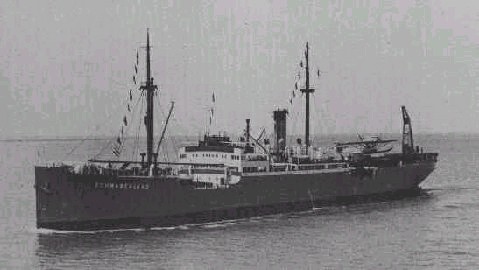
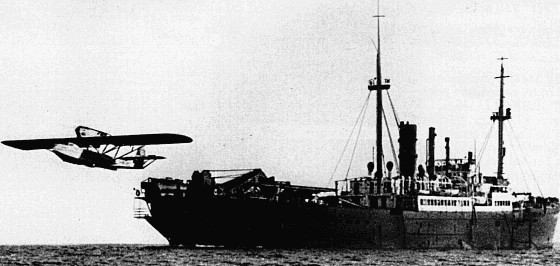
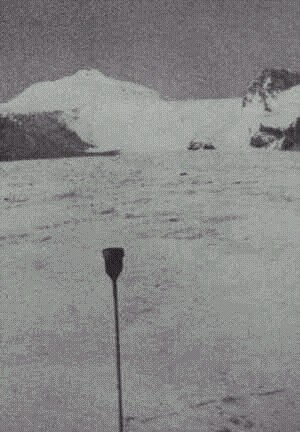
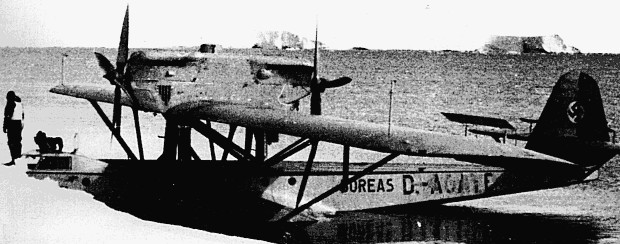
The German ship Schwabenland launches Dornier WA-30 Super Wal seaplanes over Antarctica to seize control of the South Pole. Markers are dropped with German swastikas all over northeastern Antarctica. Plans begin to colonize there by creating under-ice and underground bases and studying animal life there for food use.
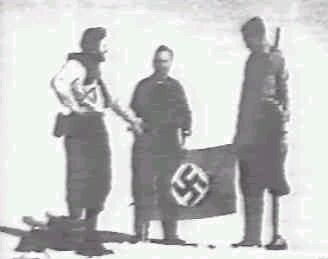
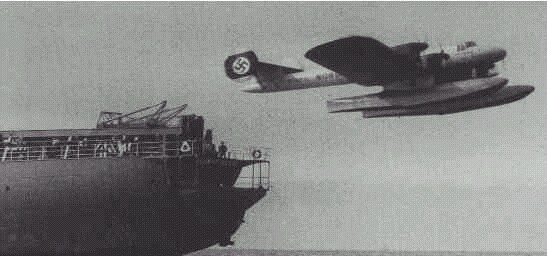
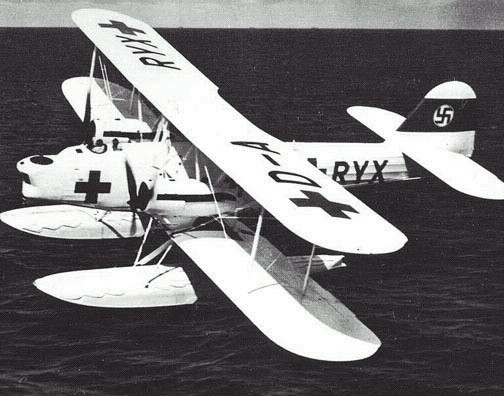
In 1940, pilots in HE-59 multi-role seaplanes landed German infantry and engineers to seize the Waalhaven bridges in Holland in a special operation.
http://en.wikipedia.org/wiki/Axis_plans_for_invasion_of_the_United_States_during_WWII
Italian long-range seaplane/mini-submarine plans
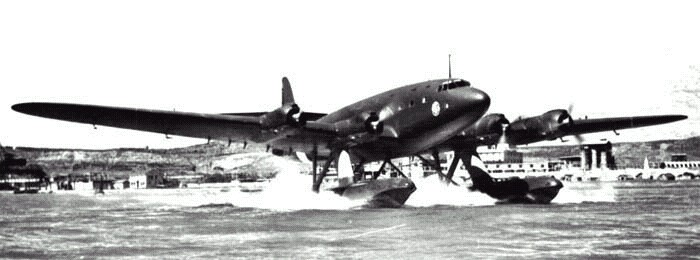
New York Harbor Attack
British Naval Intelligence leader, Commander Ian Fleming RNVR wrote about the destructive effectiveness of Italian frogmen and their mini-submarines in his James Bond novel, Thunderball. What a lot of people don't know is that Fascist Italy planned to damage dock facilities and sink ships moored in New York Harbor using Maiale midget submarines. In 1943 preparations were well underway to deploy these weapons against the United States.
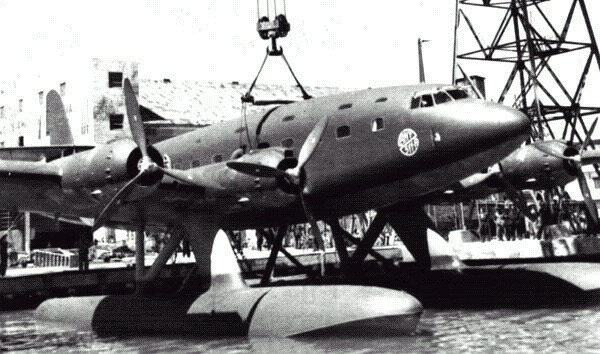
The Regia Aeronautica (Italian Air Force), working in conjunction with the Regia Marina (Italian Navy), prepared two long-range Cantieri Zappata CANT Z.511 flying boats for the operation.
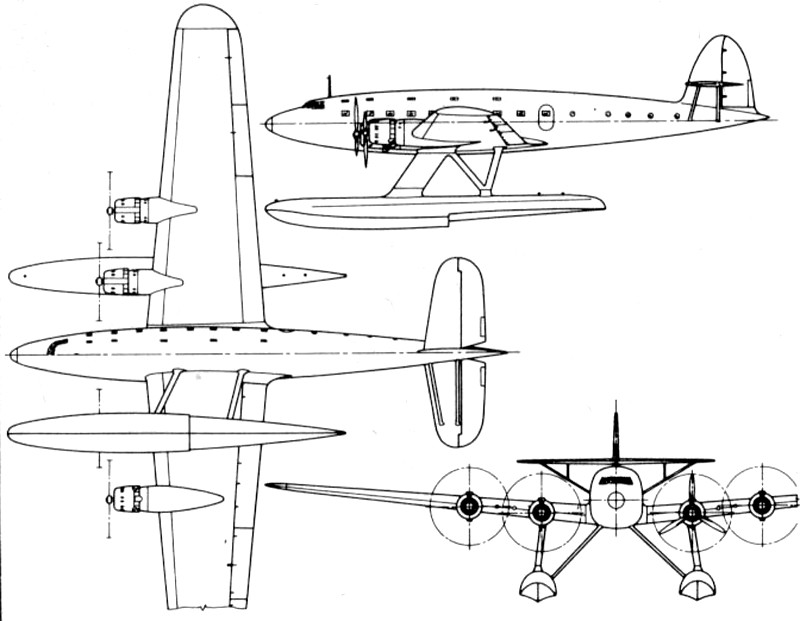
The CANT Z.511 was powered by four 1,500 hp Piaggio P.XII RC 35 radial engines giving it a maximum range of 2,796 miles. This seaplane also had extremely good stability in waters with up to 7-foot waves. It could carry two or four Maiales.
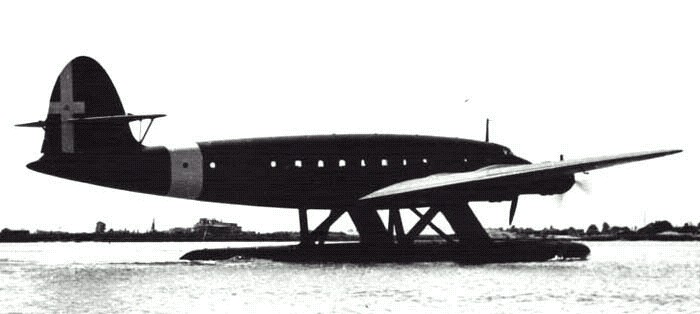
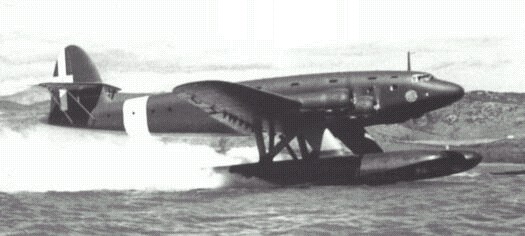
The operation was to commence as follows: CANTs flying the Atlantic would fly low under enemy radar to a point from which the midget submarines could be launched. The crews of the submarines were special volunteers, who after completing their mission, were authorized to surrender. No plans were made for returning them to the seaplanes.
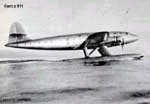
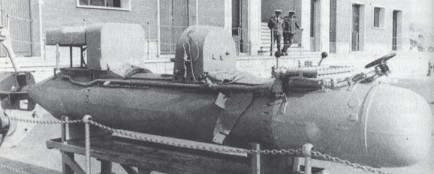
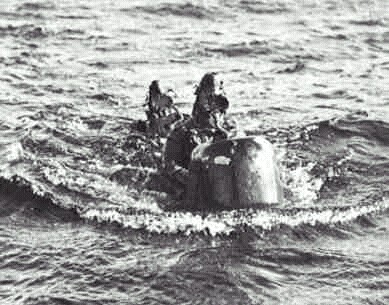
By May 1943 cooperation with supply U-boats was obtained. The CANTs had been successfully tested with Maiales man-guided torpedoes and special volunteers for one-way missions. The raid was scheduled to take place under ideal weather conditions in mid-June of the same year. However, only three weeks before, both the seaplanes and their specially fitted launch racks were partially damaged by British fighters when the CANT's base in Lake Trasimeno was strafed. The following July Marschal Pietro Badoglio declared an Italian armistice and the project was abandoned. The planned attack against New York might have scored a success paralleling the Italian attack in Alexandria Bay, Egypt during the Axis Powers' North African campaign.
Japanese I-400 submarine/Aichi M-6A Aichi Seran seaplane attack plan
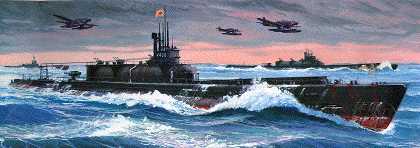
For a complete history of submarine aircraft carriers:
www.combatreform.org/submarineaircraftcarriers.htm
The Imperial Submarine Squadron One, under the command of Captain Tatsunosuke Ariizumi (I-400 "Sentoku" Class Submarine/ Aichi M-6A1 special torpedo-bomber force) was composed of: the I-13, (equipped with 2 aircraft); the I-14, (equipped with 2 aircraft); the I-400, (equipped with 3 or 4 aircraft); and the I-401, (equipped with 3 or 4 aircraft)
For the first mission, Vice Admiral Jisaburo Ozawa, Vice Chief of the Navy General Staff, selected "Operation PX", a top secret plan to use the I-400 unit's ten aircraft to unleash bacteriological warfare on populous areas of the American West Coast and Pacific Islands. On March 26, 1945, this mission was canceled by General Yoshijiro Umezu, Chief of the Army General Staff, who declared that "Germ warfare against the United States would escalate to war against all humanity".
As an alternative, the staff considered bombing San Francisco, Panama, Washington, D.C. or New York, and decided to launch a surprise air strike against the Panama Canal's Gatun Locks. Destroying these locks would empty Gatun Lake and block the passage of shipping for months. For the 17,000 mile round trip to Panama, each submarine needed 1,600 tons of diesel fuel, which was unavailable at Kure. The I-401 was therefore dispatched to Dairen, Manchukuo, to bring back the needed oil. On April 12 she grazed a B-29-laid mine off Hime Shima Lighthouse in the Inland Sea and had to return for repairs. In her place I-400 successfully carried out the undersea tanker mission.
While the submersible carriers were perfecting their tactics to cripple the Panama Canal, the Japanese Navy was steadily deteriorating. Before the submarines could set sail for Panama, more than 3,000 Allied warships and transports had reached the Pacific for Operation Olympic, the forthcoming invasion of Japan.
This growing threat forced Tokyo strategists to reconsider the attack on distant Panama, which now appeared a questionable diversion. Over his vehement objections, Captain Ariizumi was ordered to abandon his squadron's carefully rehearsed canal strike and instead attack the American naval forces at Ulithi Atoll.
During the Korean war, U.S. Navy Underwater Demolition Teams (UDTs) the forerunners of today's SEALS deployed from PBM Mariner seaplanes to do special operations.
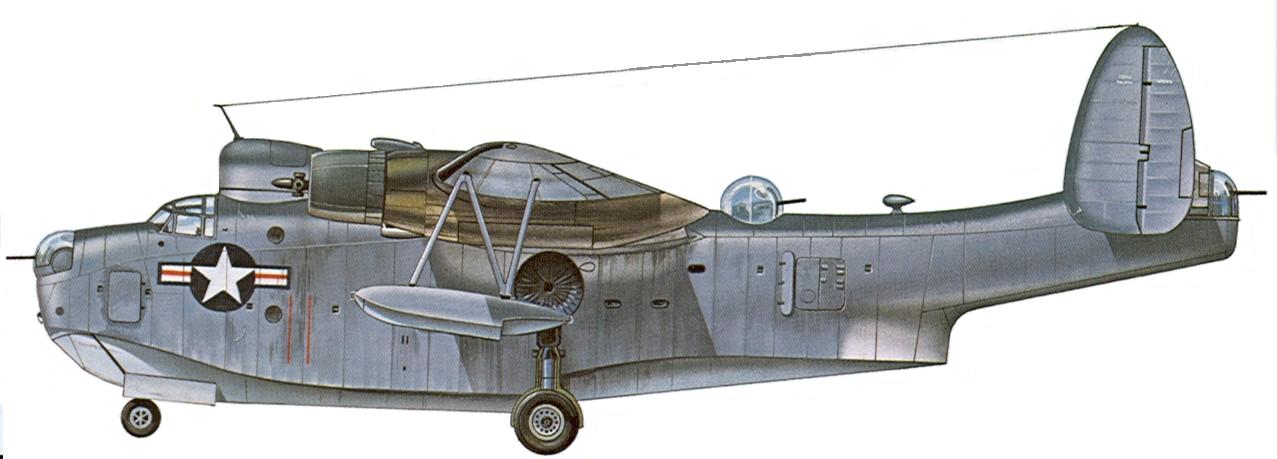
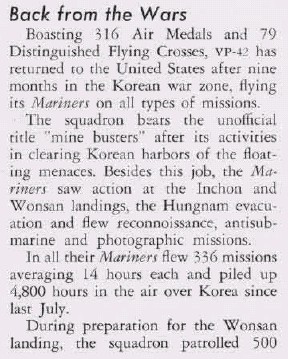

Post-WW2 re-enactment Navy/marines eliminate all the small platforms/means that compliment but in their egos threatens their large platforms
Hugging the Curvature of the Earth to Stay Undetected by Radar and Sight Over The Horizon
http://radarproblems.com/calculators/horizon.htm
The lowest altitude to parachute jump in the U.S. military mind is 500 feet. So if you are a SEAL team doing a "rubber duck" jump (boat with outboard motor on pallet with cargo parachutes you wear personnel parachute and swim fins and jump after the rubber duck is pulled off the rear ramp) you will be outside of radar detection up to 31.6 miles from target and 27.39 miles away will not be visible. Can you motor ashore these 27-31 miles in a small boat? Yes, but its no picnic.
Let's say we have the British Irvin parachutes and jump at 250 feet, radar is 22.3 miles and visual is 19.3.
Let's say we use a SEAPLANE flying 50 feet above the water. How close can we get before being detectable?
10 miles by conventional radar and 8.6 miles by visual.
Let's say the seaplane lands and has a 20 foot high tail...it can get as close as 6.3 miles by radar and 5.4 miles by visual.
Don't you think seaplanes are worth doing for special operations as an insertion/extraction means?
However, as WWII ended, the old roles and missions fights emerged again with the aircraft carrier navy pitted against the patrol and seaplane navy faction. The angled-deck aircraft carrier employs 4,000+ men and requires a full bird Colonel "Captain" to further careers. In contrast, a seaplane requires only a junior officer and a small ship to link up with in the open sea to rearm, refuel. Thus, at the end of the 1950s, these two and other factions clashed for money in the Navy budget, the outcome was the end of the seaplane in U.S. Navy service a sad state of affairs in effect to the current day. Inefficiency via a huge floating aircraft bureaucracy and welfare program in Navy blue beats military efficiency at lesser costs during the fantasy of peacetime garrison life paid for by the American taxpayers who have to work real jobs that produce real human goods and services. This abandonment of 6 decades of airplane development due to selfish interests was despite the fact that the aerodynamic handicap of flying a boat hull was solved in the 600 mph P-6M SeaMaster jet bomber. The SeaMaster, which flies faster than the USAF's mighty B-52 could have enabled the patrol navy to have a nuclear bombardment mission from many locations around the globe to threaten the communist foes of America at far greater simplicity and less tactical vulnerability and cost than the huge super aircraft carriers catapulting smaller and shorter-ranged airplanes. A squadron of SeaMasters like their B-52 brothers could better conventional ordnance bombard an enemy than an entire carrier air wing of smaller fighter-bombers. Our white paper on this subject is here:

www.combatreform.org/p6mseamaster.htm

Despite the PBY Catalina seaplane saving the lives of the cruiser USS Indianapolis after it was sunk at midnight (its own Kingfisher seaplanes were not in the air to provide ASW cover) by the radar equipped Japanese submarine I-58 in 1945 after delivering atom bombs to the B-29 crews on Tinian island, not surprisingly in light of Navy egotism--just a few short years into the 1960s with the demise of the seaplane from USN service, there were no seaplanes of any kind in any U.S. military or Coast Guard service! Once U.S. manufacturers stopped making seaplanes the entire concept became unavailable for U.S. forces. However, the earth still is covered mostly by water and when humans try to traverse the seas they sometimes have to abandon their platforms when they fail. Those that found their boat or ship disabled or their land-based aircraft dunked into the water could cling to debris and hope that a shore-based land wheel aircraft could find them and direct someone in a nearby ship or helicopter to rescue them. This sad state begs the observation that had these land based aircraft been seaplanes, even for just emergency use via the more efficient Burnelli type designs, they could have glided to a water landing and waited for rescuers instead of clambering out as individuals clinging to seat cushions for floatation into freezing waters to die of exposure and/or drown.
Today-2007 & beyond
1.) spot any survivors in the water
2.) parachute drop a life boat kit and then...
3.) dispatch a ship or short-range helicopter to pick them up hours/days later.
Compare this 3-step process to the simplicity of the WWII seaplane:
Yesterday-1940s-1960s

1) seaplane spots those needing rescue, lands, recovers them and takes-off.
Even if a helicopter is nearby, there's no guarantee that it will be able to pluck the pilot or man in the water to safety due to rotor downwash. Here's a tragic story from the Korean War of helicopter failure:

A seaplane in contrast, can land near the man or men needing rescue and then taxi up to them or send out a small boat to retrieve them.
Certainly the U.S. Coast Guard would rather fly seaplanes and effect 1-step rescue operations but NO ONE IN THE U.S. MAKES LARGE SEAPLANES ANYMORE. The Russians and Canadians make large flying boats but "buy-American" products legislation probably nips that option in the bud. So? Make them under license in the U.S.! If there is a will there is a way, the problem here is we lack the will to win.
Who is going to do "Special" air/sea Operations? Not the U.S. Navy!

After WWII, technology was poised to make seaplanes do things we never imagined possible. We had the Tradewind seaplane transport that set the prop seaplane speed record of 403 mph that still stands today. What do you mean seaplanes are aerodynamically handicapped? The C-130J of today can only do 400 mph!!!!
http://modelingmadness.com/scotts/korean/r3ypreview.htm
HISTORY
As part of the "Mobile Base Concept", the Navy had Convair develop a bow-loading Tradewind which incorporated straight-in loading. The above concept was developed by the Navy in the late 1940s around a high speed seaplane transport (the R-3Y), a jet fighter seaplane (the Convair F-2Y SeaDart) and a jet bomber seaplane (the Martin P-6M SeaMaster).
It was planned that these three aircraft could fly anywhere in the world and have a floating base set up by suitable naval vessels anchored or buoyed in sheltered water.
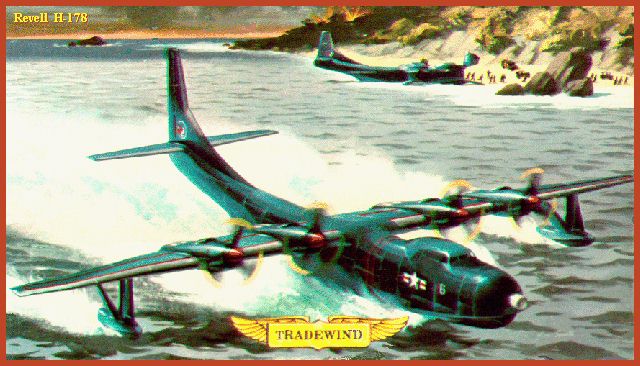
It was further envisioned that the bow-loader R-3Y2s would be able to pull up and tie up to these floating docks to offload and on-load their cargo.
In 1945, the Navy approached Convair to see what could be done about building an improved flying boat, and Convair came up with the Model 117. It was a very sleek, high wing boat with a single step hull, four Allison T-40 turboprop engines with six blade, contra-rotating props. Each engine developed 5,100 shaft horsepower and 830 pounds of jet thrust. The stabilizing floats were fixed, as there was no room to stow them in the thin, laminar-flow wing. The boat was named the "Tradewind". It first flew in 1950 after a delay of some months because of trouble with the Allison engines. The Navy received it first Tradewind in 1954. The project was re-evaluated by the Navy and developed into a transport with the new designation R-3Y. Given the beautiful name Tradewind, eleven of these impressive aircraft were built and used by the Navy on runs such as that between Alameda and Pearl Harbor.

This version could carry 80 passengers in SAFE rearward facing seats, up to 24 tons of cargo or an assault company of marines/Army troops--complete COMBINED-ARMS TEAMS with M113 Gavin or AmphiGavin light tracked AFVs more than 3,200 km (2,000 miles) without refueling. A special cargo version, designated R-3Y2 and sometimes known as the "Flying LST" embodied an upward opening nose to facilitate the loading and unloading of troops and equipment. Although the Tradewind was used for a variety of tasks, including an aerial tanker for air-to-air refueling, it proved the practicability of high-speed flying boat transports.
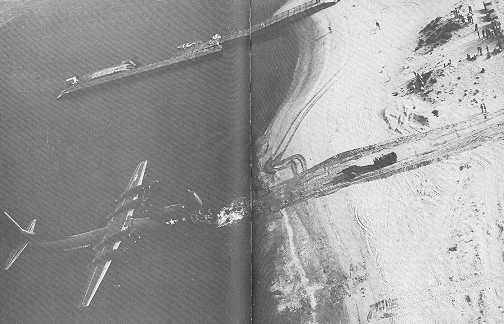
The Navy sought to use it as a patrol craft, troop transport, flying ambulance and fuel tanker. As a patrol craft, it mounted 5 pairs of 20mm guns, two on each side fore and aft, and one pair behind the rudder. The armed Tradewind could still lift 8,000 lbs of stores. It had a range of 3,450 miles without stores. This was the P-5Y and it had a much different nose section from the transport version whose nose can open.
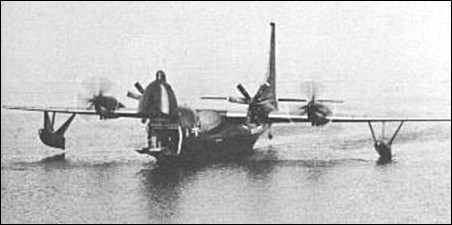
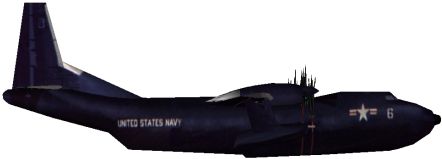
Two P5Ys, five R-3Y1s and six R-3Y2 Tradewind were built before production was terminated. What should have been one of the Navy's best and most beautiful boats was destined to be very short lived. The Allison T-40 engines were trouble from the start and the problems were never adequately remedied. One of the two original XP-5Y1s crashed and the suspected cause was engine failure. Subsequently, several more of the R-3Ys were wrecked and it was judged definitely due to faulty engines. Finally, in 1958 the Navy ordered them grounded and sold for scrap.
Do we get this right?
We have an excellent seaplane transport that could speed marines anywhere in the world at high speeds instead of having them sit on vulnerable amphibious ships for months at a time and we give them up just because of ENGINE problems?
GET BETTER ENGINES!

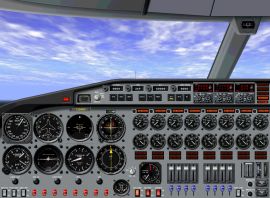
Clearly, the can-do WWII generation met the corrupt do-nothing, spend-all-we-can bureaucrats in the early '60s and we have been never the same since. Consider that if we had Tradewind type seaplane transports today, each one could splash ashore two M113 "Amphigavin" light tracked armored fighting vehicles filled with marines or Army troops inside.
HOW A 21st CENTURY TRADEWIND SEAPLANE WOULD LOOK DELIVERING M113A4 GAVINS TO THE BEACH!

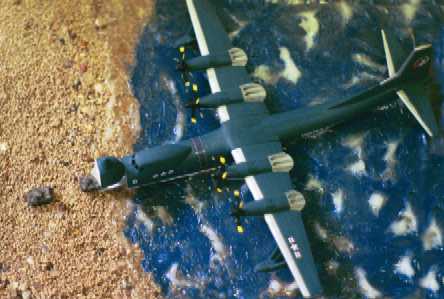
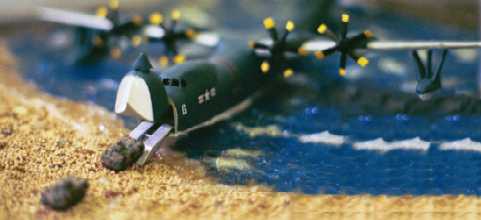

The Patrol Navy survived the aircraft carrier mafia's coup in the 1950s--barely---by the advent of land based anti-submarine warfare missions. This sub-section of the U.S. Navy now flies P-3C Orion four-engined turboprops with long endurance, but cannot land on the water to rescue anybody. While the Patrol Navy hunts for the next "Red October", the Navy's SEAL teams are parachute jumping into the water with inflatable boats and no way to recover them if their mounts fail to inflate or their outboard engines conk out. NAVSPECWAR units need seaplanes but none are to be found within the current existentialist roles and missions cliques.
The Martin Mariner was very actively involved in both WW2 and the Korean Wars, the latter combats keeping the coasts free of sea mines, and the Convair R-3Y Tradewinds counter-rotating turboprop seaplane was fielded in small numbers, though the marine corps didn't catch a clue and exploit this seaplane transport to attain world-wide rapid deployment capabilities even though the 1946 USMC Shephard/Geiger board said to get "fast seaplanes".
After the P-6M SeaMaster travesty, its predecessor, the P-5M Marlin, twin-engined transport soldiered on until 1968, missing the Korean War, but doing combat coastal patrol and search and rescue work in Vietnam.

The wear and tear of the Indochina war killed the airframes and with no replacements in sight, the narrow-minded military mindset took effect.

With smugness and defeatism, when the last P-5M flew, a ceremony was held proclaiming it would be "the last U.S. Navy seaplane". Says who? Who elected these people to be god? Why are we so quick in the U.S. military to call something useful an "end of an era" in avant garde smugness?. To make ourselves look progressive? Or just exalt laziness to do less?
At least one courageous U.S. Navy officer, Commander Leibhauser spoke out in favor of an inspired seaplane concept but tragically had his life cut short in an aircraft crash, causing America to lose its most persuasive voice for seaplanes.
CAPITAL SHIP FOR AN AIR NAVY
By Commander C. H. Liebhauser, U. S. Navy (Deceased)
See his September 1957 U.S. Naval Institute PROCEEDINGS article at the end of this web page!
Can-Do Russians: lead the way
The Russians certainly didn't give up on seaplanes using today the awesome A-40 jet seaplane patrol bomber and Be-12 turboprop patrol bomber for years. The Russians also have experimented with extremely large Wing-In-Ground effect (WIG) seaplanes.
Exit the U.S. Air Force from seaplane capabilities
When the USAF split from the U.S. Army in 1947, a trend developed in concert with the improved range/speed of fixed-wing jet aircraft: the "fly boys" stopped wanting to land anywhere they could get dirty. Mid-air refueling offered a way for less or no naval bases at all to be needed if the crew was up to the task of flying constantly. Whereas in WWII aircraft carriers and advanced naval bases were needed, these could now be bypassed given enough in-flight refueling aircraft. In a few short years, aviators in all the U.S. military became dependant upon concrete runways and comfortable quarters far away from the grunts in the mud and those in peril in the sea be it planned or unplanned. For a few years into Vietnam, the USAF Aerospace Rescue and Recovery Service operated some small Grumman HU-16 amphibious seaplanes to pluck downed aviators off the coast of Vietnam, saving many lives but the aircraft itself was old, slow and the minds of America's inventive geniuses were not coming up with new versions on the drawing board to replace them. Once Vietnam ended, the USAF's seaplane rescue capabilities were retired.
What about skis to land on the water?
The U.S. Army O-1 Bird Dog "grasshopper" ESTOL observation aircraft is an amazing plane that can land anywhere to include on the water using snow skis as long as the plane keep taxiing forward since it had no floatation. This reality that you can stay on top of the water has recently been re-learned by a flight demonstration team in T-6 Texan trainer/observation/attack planes.
So the minimalist gear required to land on the water is skis and then have your fuselage watertight when you come to a stop to float.
Inspiration from the "Greatest Generation": Michael Stroukoff to exploit skis for water and snow landings
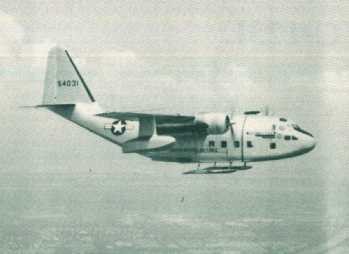

NBC news commentator Tom Brokaw is right about one thing: WWII created a crop of can-do men who overcame problems head-on. One of them was Michael Stroukoff, who created the high t-tail STOL cargo plane (C-122 and C-123) from the large assault glider CG-20. There is more. In an act of creative brilliance, Stroukoff came up with a way to make these more effective transport aircraft to land on water without need of a costly boat hull shape. The problem of the seaplane needing a high-drag boat hull was solved by using skis attached o the underside of existing cargo aircraft at less aerodynamic penalty:
www.theaviationzone.com/factsheets/c123.asp
Mr. Michael Stroukoff had been president and chief engineer of Chase aircraft during the C-123 Provider's development. The Stroukoff Aircraft Corporation produced four specialized versions of the Provider, which were used to explore short takeoff and landing (STOL) technology. The YC-123D (AF 53-8068) employed a boundary-layer control system for additional lift, and the YC-123E (AF 55-4031) was equipped with features known as the "Pantobase" system. This aircraft also was equipped with multi-use skis, a water-tight fuselage and wing-mounted pontoons for operation from water.
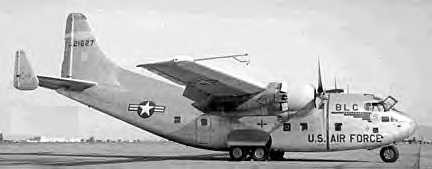
The application of boundary-layer control (BLC) and the installation of massive Wright R-3350 engines led to the YC-134 variant. The addition of Pantobase to this aircraft produced the YC-134A, which was the ultimate hardware development of the original glider design. During the early 1960s the Fairchild Company proposed a C-123 follow-up design to be powered by four General Electric T-64 turboprop engines of 2,800 HP each. This aircraft would have incorporated tandem main landing gear, double slotted flaps, short-span ailerons and a spoiler system. Though these ideas had great merit, the project did not proceed beyond the paper stage. The Advanced Medium STOL Transport (AMST) program of the 1970s produced two innovative aircraft the Boeing YC-14 and the McDonnell Douglas YC-15. When the program was canceled in 1979, these successful aircraft were retired to the boneyard. Some of the technology developed for the YC-15 has been applied to the C-17 Globemaster III Strategic Airlifter program of today. Russia appreciated the technological advance, and went on to produce a close imitation of the YC-14. The Japanese put BLC on its Shin Meiwa ASW and SAR seaplanes.
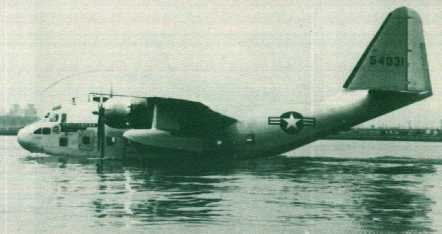
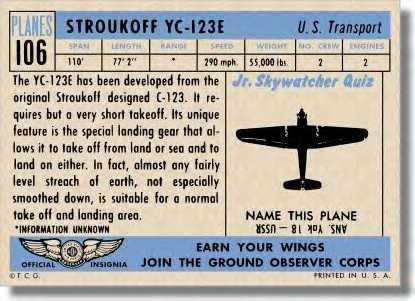
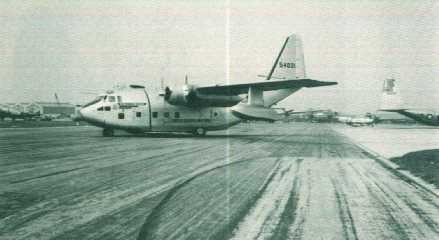
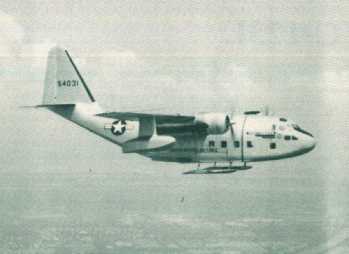
The amazing thing about the Pantobase ski system was it resulted in only a 5% loss in flight performance! Pantobase could be added to almost any aircraft by simple modifications instead of complete redesign into a flying boat hull.
Yet the USAF rejected it.
The USAF for myriad reasons wasn't interested in landing on water, snow, ice; there was no "role/mission" for it to grab budget share and glory. Later on, the need to land on snow/ice forced them to fit land skis to C-130 Hercules aircraft but not in a way that the planes could settle down in the water.
In fact, the USAF tested and perfected both tracked landing gear and air cushion landing systems [www.geocities.com/equipmentshop/c130.htm] that can enable fixed-wing transport aircraft to land almost anywhere there is a large enough vegetation opening and rejected them both. Both of these would have resulted in them being able to land away from comfortable paved runways and running the risk of getting dirty and uncomfortable. There are many excellent STOL aircraft designs available that could effect near V/TOL mission capabilities but these are held back by THEIR LANDING GEAR MEANS to achieving their full potential to land almost anywhere on the earth.
Today: no one wants to land in the water or mud?
Fortunately as the fly boy "fighter jocks" went off to their paved runways starting in the post-WWII era, Army and USAF Special Operations aviators from Phil Cocrane's Air Commandos (today known as Air Force Special Operations Command or AFSOC) to Gavin/Moore/Kinnard's helicopter Air Cavalry have used STOL and VTOL aircraft to work in conjunction with ground missions. However as small communities they have lacked the political clout and money to fully develop the awesome potential of a multi-functional, land anywhere fixed-wing aircraft. The conventional fixed-wing aircraft itself is unfulfilled with non-lift producing fuselages; the extreme STOL (ESTOL) Burnelli design turbofan has yet to be built but should be the AFSOC's M-X replacement for the MC-130 Combat Talon:
www.geocities.com/equipmentshop/goodbyeftr.htm
There is a growing realization that the V-22 tilt-rotor half-helicopter, half-fixed-wing aircraft is not good at either jobs. Mechanically over-complex, the tilt-rotor if fielded will crash often and kill lots of good people until common sense can be restored. Even if the V-22 could be made to work as advertised, it still cannot land on the water to be a seaplane and at best could hover over the water requiring laborous winching/roping to get men in and out. The USAF M-X transport to replace the Combat Talons is defacto admittance that the USMC V-22 is a miserable failure and 50 x USAF CV-22s might not be purchased if wiser heads in AFSOC weigh in on the issue.
MC-27J or MC-130J Pantobase and Super Chinooks NOW
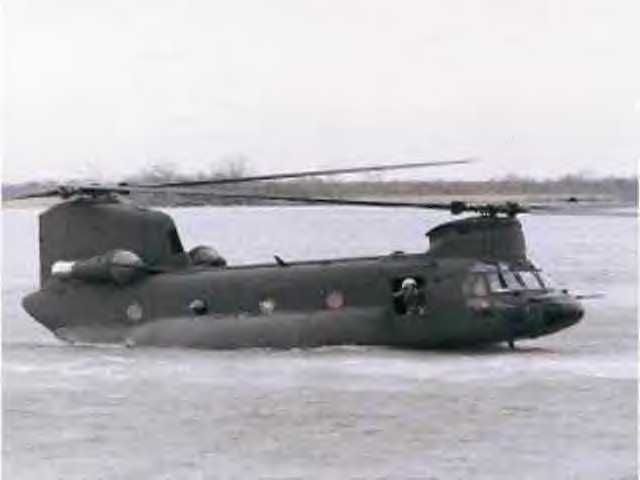
Short of an expensive new M-X aircraft design that will take years, there is no reason why a tracked landing gear with Pantobase skis couldn't be fitted to a four-engined MC-130J Combat Talon propfan to fulfil the AFSOC need for an interim Special Operations M-X aircraft in the 2004-2007 time frame. Since the V-22 is a dismal failure, the C/SAR community is considering the mighty CH-47 Chinook as its next search and rescue platform. The CH-47 is the only aircraft in U.S. military service today that can land on water though it is a slow and short-ranged helicopter. If the U.S. Navy gets into heavy combat against the Chinese communists over Taiwan there could be thousands of Sailors dying in the water needing a seaplane to land and pick them up. We advocate theCH-47 be made into a "Super Chinook" with forward thrust and wings to up its speed/range.
If AFSOC is not interested, the U.S. Army's 160th Special Operations Aviation Regiment (160th SOAR) "Night Stalkers" should purchase twin-engined C-27J propfan Spartans with Pantobase skis, wing floats and sealed fuselage to land on water, snow and ice as well as short dirt strips. Right now 160th SOAR will land MH-47E Chinook helicopters into the water to launch/recover SOF units in Zodiac F470 rubber boats with outboard engines. The technique is called "Delta Queens". However as brilliant a design as the Frank Piasecki CH-47 is, its still a helicopter in the 150 mph/200 mile "box". 160th SOAR helicopters can in-flight refuel but this is problematic; getting adequate C-130 type tankers in position is not a sure thing nor even getting hooked up to refuel; consider the Blackhawk helicopter in the "Perfect Storm" that couldn't connect to the fuel nozzle due to severe weather winds and ran out of fuel, ditching into the sea. 160th SOAR's CH-47s should be made into "Super Chinooks" for greater speed/range.
Its clear that for long range missions across oceans, that U.S. Special Operations Command units need a fixed-wing seaplane to deliver and recover units in small boats as well as combat swimmers. If done with the Pantobase ski system, an USSOCOM seaplane could be a modified C-27J Spartan or C-130J Hercules aircraft type already in use by the U.S. military. A "MC-27J" or "MC-130J" seaplane could fly the entire mission under enemy radar, low over the water exploiting the curvature of the earth to evade detection, then land in the water to deploy combat swimmers and/or small boats or mini-subs. A seaplane would not need to pop up to parachute jump altitude (at least 250 feet) and break radar evasive flight profile. The ability to land in the water and be stationary is vital to safely delivering and recovering men, boats and even small amphibious tracked vehicles like M113 Amphigavins
www.geocities.com/armysappersforward/amphigavins.htm
Lockheed in the past has stated that for a Herk to land on the water its turboprop engines need to be inverted to keep sea spray out of the air intakes. The YC-123E had a simply sealed fuselage; it lost the ability of its rear ramp to open. If the simple watertight approach is used, a C-27J or C-130J seaplane would need redesigned side door or doors so SEAL team boat packages could be pushed out. Another possibility would be a shelf high up on the rear ramp so the upper cargo door could open for a boat platform to be pushed out above the waterline as the aircraft sits in the water. If the sealing at the rear ramp can be reliable and watertight enough for sea landings and still open-able for land operations, then loss of the rear ramp would only apply to sealanding deliveries; the USSOCOM seaplane could still parachute airdrop and STOL airland over the rear ramp. In the event the rear ramp cannot remain openable, the two side jump doors, perhaps one a larger cargo door type would enable paratroops and small cargoes to be airdropped. The wing pontoons necessary to keep the wings from dipping into the water could retract outward to the wingtips like on the PBY Catalina to reduce in flight aerodynamic drag.
The money already exists for MC-27J or MC-130J Pantobase seaplanes
The above modifications to a C-27J or C-130J would be SOF-unique and would be eligible for MFP11 funds from Congress. Perhaps after USSOCOM shows the rest of the U.S. military the benefits of the Pantobase kits, other potential users like the Coast Guard and the conventional USAF might equip some of their C-130s for rescue purposes. With the abandonment of Fulton Surface-To-Air (STAR) "Skyhook" recovery means on MC-130 Combat Talons in AFSOC, special and rescue operations have a void in their capabilities that could be partially filled by Pantobase landing capabilities.
Old Idea, new era = lives saved
The advent of MC-27J or MC-130J Pantobase seaplanes in U.S. military combat and rescue service would result in many lives saved both in peace and war. The return of the seaplane would open up many new mission options for planners to exploit the element of surprise which is hard to obtain in a world where everyone has a telephone and a computer to report military activity. For a very low cost, Pantobase seaplane kits could be developed and fielded to achieve these new capabilities. Its also very clear that we have only begun to utilize our fixed-wing aircraft capabilities and that the missing ingredient is LANDING GEAR technology that could make any grassy field a landing strip; tracked and air cushion landing gear could open up new, unbelievable places for access by fixed-wing aircraft. We have also not fully optimized the fixed-wing aircraft aerodynamics to need the shortest and slowest take-off runs via efficient Burnelli-type lifting fuselage designs. We think these capabilities have not been pursued due to a desire on the part of aviators who control budgets and which projects are funded to live pampered lives from fixed airbases. The full potential of fixed-wing aviation to enrich mankind is not being fulfilled due to an absurd selfish desire to avoid having to land on unimproved surfaces, and this has created another faction within aviation that seeks to land and take-off vertically through inefficient and sometimes dangerous, unsafe means in order to be more useful to mankind. We are over-compensating for fixed-wing aircraft design intransigence by looking towards mechanically over-complex and unsafe V/TOL means like the V-22 when all we often really need is a very good short take-off and landing capability and a little prior assault zone reconnaissance and elbow grease combat engineering to make a short runway.
UPDATE! SKIS AS HYDROFOILS?
Another excuse people try to use to deny the overwhelming reality that seaplanes are necessary is that in some really rough sea conditions a boat hull seaplane may not be able to land safely. Pantobase skis should solve this, if not if there were hydrofoil skis on the seaplane less surface area would have to cut through the water to land.
The International Hydrofoil Society web page reports: Hydrofoil Articles in Popular Magazines
http://64.233.161.104/search?q=cache:ipQLBaNJJfkJ:www.foils.org/popmags.htm+seaplanes+amphibious+assaults&hl=en&ie=UTF-8
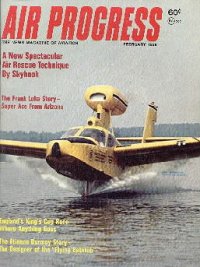
Levy, Howard, "HRV-1 Hydrofoil Amphibian," Air Progress - The News Magazine of Aviation, Condé Nast Publications, New York, Feb 1968, vol 22 no. 2, pp. cover, 38-39, 73-74. "... the hydrofoil seaplane can operate in sea states three times the size safely handled by a basic seaplane... For almost five years, David B. Thurston, President of... Thurston Aircraft Corporation of Sanford Maine has been conducting relatively unpublicized hydro-ski and hydrofoil development and flight evaluation programs for the U.S. Naval Air Systems Command (NAVAIRSYSCOM)... It was during Spring 1964 that the Naval Air Test Center at Patuxent conducted an evaluation of an Edo-developed Grunberg hydrofoil on a Grumman JRF-5G... A second generation seaplane hydrofoil configuration called for a single, small foil positioned below the hull. The resulting design was a single supercavitating, penetrating hydrofoil considered suitable for use on the Grumman HU-16 Albatross... a modified 1960 Lake LA-4A Skimmer amphibian was chosen as a scale flight test bed." Note, a summary of David B. Thurston's accomplishments is posted on the web, and includes information about his work with hydrofoil amphibians at Thurston Erlandson Corp
Clearly there are a host of technologies yet to be fully exploited to make the most of seaplanes for military service.
About airliners....flying from jeopardy to jeopardy
The entire civil aviation industry lives in denial and hubris that aircraft will not crash when they WILL CRASH despite doing everything in our power to make safe pilots, engines and airframes (PEA). The 1st TSG (A) has long argued that PEA must be buttressed with HUMILITY that there must be an alternative "plan B" which could be recovery parachutes (RPs) to bring down the entire plane and---you guessed it a seaplane hull shape that can land on water. The AeroPeru Flight 603 crash into the water when the mental instruments failed shows painfully why we need PHYSICAL capabilities to land anywhere instead of desperately having to go from airfield to airfield. Had the AeroPeru Flight 603 been a seaplane and not a bogus Boeing 757 that can't even ditch well let alone land safely in the water, they could have called it a night, cut the power and placed night vision goggles on and landed in the water and waited for rescue. When helicopters develop PEA trouble, they can put down almost instantly anywhere using their V/TOL capability. 70% of the earth is covered by water---long range airliners should all be seaplanes that can land instantly in the water if PEA trouble arises. Think of Swiss Air Flight 111 that had smoke in the fuselage that burned up trying to turn back to shore and reach a land runway. Had Swiss Air Flight 111 been a seaplane it could have landed on the water instantly and fought to put the fires out and/or got everyone into lifeboats. If aviation is to prosper in the 21st century it must stop being arrogant and restore confidence back into the flying public and admit PEA has its limits and employ some humility and have recovery parachutes and an ability to land safely on water incorporated into aircraft systems.
Lastly, airliners that can land in the water can decongest our international airports further increasing safety by less cluttered air spaces and eliminating planes flying over land homes.
Boeing's Wing-In-Ground (WIG) effect "Pelican" seaplane, why not?
The Navy/Mc should be all over Boeing's new huge Pelican WIG seaplane transport, but are not. Why? Even their Generals/Admirals after WWII saw the handwriting on the wall and called for "fast seaplanes". As the Europeans build the 600-passenger A380 deathtrap that can only take-off and land on runways, Boeing has a safer and larger plane but the U.S. military is not interested. Is it a wonder we had more air and sealift in WWII than we have today? Maybe if we spent less time idolizing the WWII "Greatest Generation" and spent more time emulating them we would be able to get Bin Ladens with decisive strategic maneuver instead of deploying handfuls of forces that enable sub-national enemies to get away?
FEEDBACK!
APPENDIX
 CAPITAL SHIP FOR AN AIR NAVY
CAPITAL SHIP FOR AN AIR NAVY
By Commander C. H. Liebhauser, U. S. Navy (Deceased)
SEPTEMBER 1957 U.S. Naval Institute PROCEEDINGS
COMMANDER LIEBHAUSER lost his life in the crash of his plane while he was serving with Anti-Submarine Squadron 39 (VS-39) in 1956. He had graduated from the U. S. Naval Academy in the Class of 1942, served in the Wichita in World War II, in the Onslow in the Korean fighting, attended the Armed Forces Staff College, and instructed at the U. S. Naval Academy.
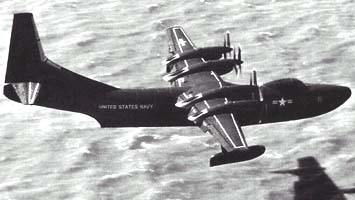
Courtesy Consolidated Vultee Aircraft Corporation. CONVAIR XP5Y-1. The world's first turboprop flying boat - 1952. Four Allison XT 40-A-4 engines drove as many sets of counter-rotating propellers giving this 60-ton aircraft a top speed of 350 mph and a 30-second take-off. The R3Y Tradewind series has been developed from this experimental model.
Although great changes have been made in military weapons in the last century the general principles of warfare have not been radically altered, nor has the old adage that "offense is the best defense" been proven in error. The objective has always been to carry the fight to the enemy wherever he may be. To achieve that objective we must constantly search for new weapon systems, or revitalize those which have been neglected in the past. To provide the punch for those weapon systems the Navy must vigorously develop and redevelop units which can best carry the fight to the enemy, combining the best advantages of surface, sub-surface, and air media. Therefore, just as the oared galley gave way to sail, and sail to steam, we may now have a new contender for the title of capital ship-the large Seaplane.
While other forms of naval air power have forged ahead in their technical development, with equivalent expansion of their tactical. employment, the Seaplane has moved along slowly in the shadows of its modern land-based counterparts. Most hindrances to this development have been technical, for instance the lack of suitable power plants. And more often structural lines have been less suited to aerodynamic than to hydrodynamic requirements. Only recently has any radical change been made in Seaplane design. Yet that change has almost closed the gap between the development of large land-based aircraft and large Seaplanes. Further progress may eliminate that gap altogether, and we can obtain a weapon system which will extend naval power beyond its present limit and provide a water-based, high-performance, long-range complement to the large carrier-based aircraft.
LAND AND SEA PLANES
Development of the Seaplane has been slow, at times almost to the point of stagnation. Although the value of waterborne aircraft was recognized early in aviation history, progress in Seaplane design fell behind that of land planes after its initial successes. Glenn Curtiss flew the first successful float plane in 1911 and went on to build and fly the first flying boat in 1912. In the years immediately following, many large flying boats were built for naval patrol duties, with adaptation to commercial use on long overwater routes not long following. A twin-engine Seaplane, the "America," was commenced in 1912 by Curtiss for a projected trans-Atlantic flight. By successive redesigns it became the FSL of 1918, one of the large flying boats which saw considerable active service in World War I. And among the military aircraft of the 1920's were included numerous Seaplanes, both flying boats and float planes.
Man, being primarily a land creature, however, could be expected to concentrate on an air vehicle completely dependent on land as a base, without the necessity of including water as a transitional medium. This undoubtedly was the principal factor which led development of the land-based airplane to the neglect of the Seaplane. To their aerodynamic disadvantage the large Seaplanes that have been developed and built have almost always emphasized the need for seaworthiness. It must be remembered that most Seaplanes have been constructed for and by mariners, who have naturally expected these Seaplanes to perform well as boats. In fact, most large Seaplanes in the past have been little more than flying "boats," and not water-based aircraft. Many Seaplanes were more often frankly boat structures with the aerodynamic portion added. The best example is the famed Dornier DoX of 1929; boat plus wing plus engines on top. Size limitation itself was a great factor hindering the development of an adequate Seaplane and providing the main reason for the unusual hull configuration generally associated with the flying boat. Seaplane hulls were required to be sea-worthy and so required deep hulls with large frontal area; engines had to be positioned to give propellers clearance above the water, which strongly affected wing locations and hull shapes; seadromes had to be well protected so that wave heights were not excessive, tending to limit the number of large seadromes and the flexibility of Seaplane movements. All these factors are rendered less critical by an increase in overall size.
Most overseas airline routes were originally pioneered by large Seaplanes. Large flying boats for the lpng overwater trips were built by Boeing, Consolidated, Douglas, Martin, and Sikprsky in the United States, Saunders-Roe, Supermarine, and Short Brothers in Great Britain, and by aircraft builders in Germany, France, and Italy. The "clippers" operated by Pan-American Airways on trans-Atlantic and trans-Pacific routes werewellknowli. German-built Dornier flying boats were designed expressly for the purpose of providing trans-Atlantic mail service.
The obvious fact that the Seaplane was by design restrictions not capable of performing well in comparison to the equivalent land-plane caused attention to diminish in its development. Lack of enthusiasm, and the development money along with it, caused a corresponding progressive lag in Seaplane construction. Since only a very few commercial overseas airlines had direct need for Seaplanes, there was comparatively little incentive for aircraft builders to take great strides in the development of improved models, and as a result the number of aircraft companies in the United States continuing to construct large Seaplanes narrowed to two at present, Consolidated-Vultee and Martin. It was left to the Navy to keep the Seaplane going, because the majority of aviation interest, both military and commercial, was turning to the landplane.
This trend was accented during the years 1942-1945 when many large airfields were constructed all over the world. Routes originally suitable only for Seaplanes became practical for large landplanes. Commercial airlines then began to purchase large numbers pf landplanes to replace the few Seaplanes on overseas routes. One very good reason was that advance type Seaplanes had not been attempted on any appreciable scale, and large airfields were now available at stations formerly used by flying boats, with a second good reason the fact that the same aircraft type could now be operated on both long overland and overwater flights. Range of the larger landplanes became sufficient for the longest regular flight, and increased reliability overcame the fears of long over-water flight in an aircraft which could not float. At the same time the speed advantage of the sleek landplane over the still lumbering flying boat permitted faster schedules. Many naval patrol plane duties were given over to landplanes for similar reasons, since, when the need for a patrol plane having a higher performance arose during World War II, there was no Seaplane in a sufficiently advanced stage of design available, and the landplane was substituted. Thus, except for a limited naval use, the Seaplane flying "boat" was becoming a fast disappearing type.
Nevertheless, the Seaplane has not been completely abandoned as a long range commercial transport. The Saunders-Roe Company has built several very large "Princess"- class flying boats of high performance and long range, designed to be powered by ten gas turbines, eight driving co-axial propellers and two mounted singly. Although the prototype has been flight tested successfully, completion has been suspended while awaiting improved power plants.
Although the Seaplane has been given comparatively little attention in recent years, the future indicates a need for increased emphasis on water-based aircraft, and particularly the large "hulled" Seaplane. (To differentiate between the modern blended hull configuration and the historical flying "boat," I will refer hereafter to the former as a "hulled" Seaplane, as compared to a "float" Seaplane.) Only the large water-based aircraft can fulfill certain performance and operational requirements which are becoming of steadily increasing military importance.
MILITARY REQUIREMENTS
The general requirement, the objective, is to be able to carry the fight to the enemy. It is well to remember, however, that mere point-to-point transportation of destructive effort is not enough. Besides the means for offense, a defensive capability must exist in some form; penetration of a strongly defended area may be necessary if a vital target is to be attacked. And we cannot assume that any enemy target which we may attack will be defended with less vigor than would our own forces display under similar circumstances. .
It has long been axiomatic with warship constructors that it is impossible to construct the ideal single fighting unit. Sharp compromises must often be made in speed, operating radius, and armament. In fighting aircraft, these compromises become even more acute. The present day aircraft, whose overall weight is sharply limited, have concentrated mainly on armament for offensive action, depending on speed and altitude for defense. Little weight can be spared for defensive armament. There defensive tactics must depend principally upon evasion and deception. As a result, the gun-defended bomber is already outmatched by the rocket or missile-equipped interceptor fighter and the surface-to-air missile.
It is very obvious that any aircraft built to carry an adequate combination of offensive and defensive weapons at long range against a determined and prepared enemy must be a very large aircraft. An excellent example is the present effort to construct long range, high performance bombers such as the B-36, B-52, B-58, and B-60. The need for range and adequate payload dictate their size. Yet all are far from optimum in either performance or fighting capabilities. Only one possible compromise appears to exist, that of providing several very large aircraft, operating in company, carrying a portion of the necessary means to take offensive action against the enemy and to counter action from the defensive efforts of the enemy.
A retreat from the requirement of a very long-range aircraft would seem to be in order . Reducing the overall range of the aircraft does several things at the same time. First of all the fuel requirements may be vastly, reduced (though with the prospective use of a nuclear-fueled power plant, this point may be discounted). More important, however, is that, with shorter ranges, escorts may be provided in the form of fighter aircraft which cannot enjoy the great range of the bomber or long range attack plane. This, however, is the situation we face at present, and which places us in danger both from our friends and our enemies. Bases of the complexity and size which are required for operating large aircraft capable of carrying heavy weapons even at medium range, and providing also for their escorts, are not only costly but entail elaborate construction and political dependence, since we must rely on allies for the land on which these bases must often be built. Nor is the provision of fighter type escorts necessarily a completely adequate defense. Medium range is also a two-edged sword; our enemy is also much closer to us, and so these bases become sorely in danger of a concentrated effort on the part of the enemy which, with their demise, and lacking a suitable alternate, would leave us without the ability to fulfill our original requirements.
Courtesy Consolidated Vultee Aircraft Corporation. R3Y-2 Tradewind - The "Flying LST." A cutaway sketch shows the load possibilities of the transport version of this flying boat. Over 100 rearward-facing passenger seats can be installed or 92 litters for hospital plane use.
Generally larger aircraft are required to obtain the needed overall performance. Since aircraft presently in use have not reached the optimum in desired performance, additional increases in range and payload can be obtained only by a further increase in aircraft size. And as the trend toward larger and larger aircraft continues, the problem of landing speed becomes more and more acute. Runways must always be finite in length, with extensions being obtained at great cost And when we consider the situation confronting the pilot of a large and heavily loaded aircraft on take-off, the available runway often seems much too short. Also obstacles, both man-made and natural, can usually be found surrounding any airfield. Once the boundaries of an airfield have been established, the surrounding country seems to move closer-as witness the difficulties confronting many cities desiring to enlarge their air terminals to accommodate the latest aircraft, and meeting the prospect of expensive condemnation proceedings of developed properties adjacent to the long-established boundaries, set originally with little regard for possible future expansion.
ADVANTAGES OF SEAPLANES
Size of runways, both in strength and length, must continue to increase in order to satisfy the inescapable war demands for increased weights and speeds. These same demands also confront the aircraft designer when aircraft strength is to be considered. For a land-based aircraft must have landing gear strong enough to sustain its weight, and strength members designed to take concentrations of load both during landing and for its entire period of ground operation. No such concentrations of load during normal landing occur in hulled Seaplanes, since water contact is distributed over a wide skin and structural area. And as flight approaches the speed of sound, a large portion of, the same skin area which requires high strength to absorb hydrodynamic loads requires a greater strength to absorb the aerodynamic loads imposed. This structural requirement of any high speed aircraft gives an equivalent of landing gear to a hulled Seaplane at little or no cost in weight.
The safety factor over water cannot be neglected. For commercial purposes, passenger safety is the consideration. However, for military purposes the possible recovery of combat-damaged aircraft is to be reckoned with. Recovery possibilities are excellent for Seaplanes, with size favoring the chances of the larger aircraft. An early illustration of a' flying boat's capability in this respect is the sea voyage of the NC-3 under. Commander John H. Towers. As one of the three-plane unit on the first trans-Atlantic flight in May, 1919, the NC-3 was brought down by fog 220 miles short of Horta in the Azores. AlthoUgh damaged, the remainder of the trip to port was made under her own power on the surface. Thus the NC-4 under Lieutenant Commander Read became the first successful trans-Atlantic plane reaching Plymouth, England, on May 31, 1919. A similar surface voyage was made by a flying boat under the command of Commander John Rogers en route from San Francisco to Honolulu in 1926. Because of fuel shortage a sea landing was made after a distance of 1,841 miles, and the PN-8 was then sailed for nine days before reaching the islands. It is quite obvious that a landplane under like circumstances would have been then, and now, a total loss with a possibility of great loss of life among those aboard. The structural requirements to enable a larget land-based aircraft to ditch successfully, either when forced down over water (or a "crash" landing in the event of landing gear failure), need not be considered for a hulled Seaplane of equivalent size. The hull not only enables the Seaplane to make a normal water landing in lieu of a sacrificial ditching, but also has the built-in strength to enable it to make a successful land ditching in the rare event when no water area is available.
Several factors have limited the operations of present day Seaplanes. Because of relatively modest size they are restricted for normal operations to sea conditions found only in comparatively sheltered harbor areas. This same size hindrance places a limitation on the destinations they must reach in periods of extremely bad weather. And their dependence on facilities makes it almost mandatory that flights terminate at certain stations which can provide for their wants. All these restrictions disappear progressively as seaplane size increases. Maximum sea conditions for safe and normal landings are revised upward; open water may be used as a landing area for much of normal operations or in an emergency. And in general, elaborate terminal instrument facilities become unnecessary since the Seaplane is not iequired to land within a closely defined space on a rigidly prescribed runway course. With suitable search radar to investigate surface conditions, adequate charts to determine the the existing depth of water, and suitable terrain height-finding equipment, any large river, lake, bay, and., except during storm conditions, the open ocean may be used as a landing area. After landing, and if in shallow enough water, an anchor may be dropped and a dangerous terminal weather condition allowed to clear before proceeding.
However the need for a landing area becomes less critical as range and fuel reserve increases and vanishes altogether when the fuel problem is eliminated. For all practical purposes that is the very situation when nuclear propulsion is added to the picture. Here again the Seaplane has a number of advantages. One principal advantage is its almost unlimited potential size. Designers have already anticipated the problem of great weight for an airborne atomic power plant to the extent that partial shielding has been considered. Nevertheless, the shielding of the nuclear reactor, whether complete or partial, will have to be quite heavy and will require a very large aircraft to carry it. Operations of a land-based, nuclear-powered aircraft would require completely new facilities, isolated for one thing, since with partial shielding the entire airfield proper, and a large area surrounding the approaches to the runways, would have to be closed off to all persons not protected by shielding. Also storage and disposal of the nuclear material presents a grave problem. One proposal is to place the "hot" reactor in a waterfilled pit after landing, since water is in itself an effective shield. A large Seaplane solves much of the dilemma, in as much as use of isolated takeoff and landing areas could be obtained without any form of construction (merely a designated "danger area" on a chart), and having large quantities of water immediately available, without even removing the reactor from the plane, if need be. That these factors and others have been given full consideration is quite evident.
Courtesy Martin Aircraft Company. First of the true jet-age Seaplanes - XP6M-1. Although the first two P6Ms crashed, the Seamaster with a speed of almost 600 knots and normal cruising ceiling of 40,000 feet appears to be the logical link between the propeller-driven flying boats and the huge, nuclear-powered Seaplanes that are still only an aeronautical engineer's dream.
During hearings before the Senate Appropriations Committee it was announced by the Chief of Naval Research that "our research has also included design studies of a nuclear-powered Seaplane."
Projection of land-based airpower toward an enemy always faces the alternate problems either of vulnerable installations id proximity to an enemy, or elaborate bas~ establishments to operate a long range, high-performance aircraft. When we contemplated use of Seaplanes, both problems are completely eliminated. The extremely versatile Seaplane, once the effort and expense is made to develop it, requires very little if any fixed base installations other than the industrial facilities needed by all aircraft for construction, major repairs, and periodic overhaul, not unlike the needs of ships for both advance base and shipyard facilities. However, base facilities need not be rebuilt due to a change in the landing and takeoff performance or an increase in the gross weight of the larger Seaplane. And the tactical mobility gained by the aircraft component of the weapons system is not diluted by the strategic immobility of its base of operations.
In fact the keyword of the proper use of military Seaplanes has always been mobility. By the use of floating base facilities, Tenders, tankers,and stores vessels, a Seaplane base can be picked up and moved at will, using the same base facilities repeatedly, and requiring little more advance preparation than an adequate portfolio of properly prepared charts. The runways will be completed upon arrival, for water is much the same with very little exception throughout the world; it can be depended upon to maintain a reasonable standard consistency.
The advantages of the large Seaplane can be well combined with those of the submarine, making a strategic team which is unsurpassed in flexibility. Extreme mobility is possible, for the stealth and strategic mobility of the submarine is combined with the tactical mobility of the aircraft. Refueling of a flying boat by a submarine was employed by the Japanese in World War II in several instances.
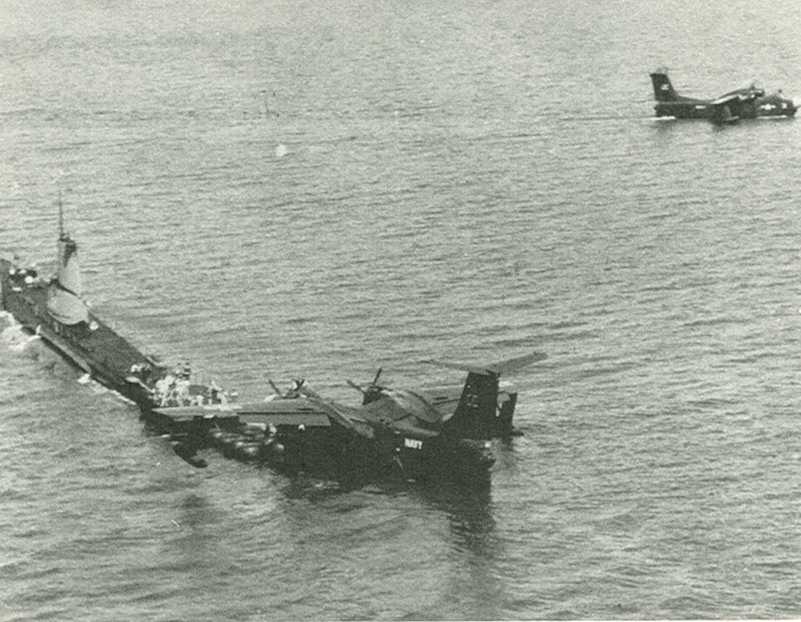
And recently, during February, 1955, fueling at sea of a P5M Marlin by the USS Guavina was conducted successfully proving the technical capabilities of this Seaplane/submarine team. The operational potentials of this combination have yet to be fully investigated. No advance preparations ashore are required, however, and since the submarine need inform no one of its presence in the area, a base of operation can be established, or disestablished, with no other notice than the orders to the sub-surface and air umts concerned. We are then able to make an extreme dispersal of forward operating bases (and change their locations practically at will) while at the same time permitting a --concentration at any point by judicious advance deployment of Tender submarines. The need for direct flight from principal base to target can be eliminated, both as to course and timing, enabling a Seaplane force to attack from many possible directions. And enemy undercover surveillance of base facilities becomes ineffectual, for the Seaplane advance base would be located at sea, or in some hitherto unprepared and unexpected area.
A further great advantage accrues to the larger Seaplane-that of relative self-sufficiency. In designing aircraft the gross weight can be increased at a much greater rate than the weight of the crew and operational equipment required to man and operate the aircraft. Therefore extra crew members may be carried) and additional facilities for the crew installed, all of which make the unit more self-sufficient. It may then be capable of normal operation for considerable periods of time in peace or war without th.e dependence upon any base facilities, whether ashore or afloat, with a specific weapon load carried at all times-much as naval vessels usuallyoperate. Continued active operations would depend only upon the provision of fuel, foodj and expendable ordnance, without any extensive base facility. Most large naval patrol Seaplanes in the past have included this idea in their operational capability with various degrees of success. However, in general the larger the Seaplane, the greater has been its ability to provide for itself.
Courtesy Martin Aircraft Company. P5M-2 Marlin - The Navy's current patrol Seaplane. This improved Marlin, which went into regular service in 1954, incorporates design features which point the way toward the larger and faster jet-age Seaplanes that may prove to be the "capital ship" of the air navy.
AIRBORNE SEA POWER
The modern hulled Seaplane, a large, water-based aircraft in contrast to the flying boat, makes possible a new concept in naval air warfare-aerial task forces to assist in maintaining the combination of sea and air supremacy. These large fighting Seaplanes are a logical step in the advance of naval warfare-highly mobile, long range striking power, together with an equal capability of self-defense necessary when penetrating into disputed areas. Alexander de Seversky stated it thus: "Technologically the airplane is an extension of the surface vessel, the climactic stage in the evolution of ships through the sprouting of wings." As an airborne man-of-war, the Seaplane can enjoy every logistic advantage of the naval vessel, plus the ability to deploy and concentrate forces rapidly and at great distances.
The technical developments in aircraft necessary for this new concept in air warfare have been reached. The first of the new look in Seaplanes featuring a high length-to-beam ratio is already a fully operational aircraft, the Martin PSM Marlin. Another new development along these same general lines is the Convair R3Y Tradewind, a turboprop powered aircraft which only recently broke the speed record in coast-to-coast flight for transport aircraft, making a 2,400 mile westeast flight between San Diego and Patuxent River, Maryland, averaging 403 mph. Although designed originally as a patrol aircraft, the PSY, it has been, redesignated, and will be placed in service as a high speed transport.
A more advanced design is the Martin XP6M-l Seamaster, a jet powered Seaplane. This aircraft, in the 600 mph class, is comparable to the B-47 in performance and is capable of being scaled up to much greater dimensions, limited only, by manufacturing facilities. This fact was emphasized in a recen t press conference held by Secretary of the Navy Charles S. Thomas, who stated that "there is no reason why such aircraft [jet flying boat bombers] shouldn't be as large as we care to build them." In fact, aircraft of much largei proportions could be constructed in regular slipways, with the wing sections added during the final stages of construction. The normal home for such giants of the sky when not flying is logically in the water, for service, repair, and storage. unlike ocean-going ships, these aircraft could be flown to inland bases on fresh water rivers or lakes for hull cleaning and major maintenance.
Nor are these the end product in the perfection of water-based aircraft. Experiments with trans-sonic and super-sonic hydrodynamic aircraft have had considerable success. The "Skate" and "Betta" projects under Navy sponsorship give promise of a whole family of aircraft whose aerodynamic abilities are not compromised by the fact they use water as an operating medium. Overall configuration of aircraft based on these design criteria equal or better the performance of similar aircraft designed for land use, yet have advantages common to Seaplanes.
The operational units of a Seaplane striking force are now technically possible-naval units which are strategically adept, tactically agile, and which can carry a powerful punch. Therefore it would be highly appropriate to call the early versions of this new concept of fighting aircraft an aircraft cruiser, and give it a proper naval designation-"VCC."
Configuration of a prototype aircraft cruiser would give it the following characteristics :
Aircraft Cruiser (VCC) Gross Weight 600,000 lbs.
Engines 8 jet @ 15,000 lbs. thrust each Speed 600 kts.
Range 6,000 miles Length over 200 ft.
Wing Span over 200 ft. Draft 10 ft.
Ordnance -
Offensive armament bombs, mines, air "torpedoes"
Defensive armament - short-range aimed rockets, guided missiles such as the U. S. Navy "Sparrow" and USAF "Falcon"
Electronics Communications, Navigation, Search and Countermeasures
Crew 20
Because these dimensions are rather limiting, they placed some arbitrary restrictions on performance and fighting ability. Further developments could easily sacrifice some speed for greater range, endurance, and combat capabilities; or, since there is no limit to size beyond the facilities to construct the airframe, we could increase the unit dimensions. Also, somewhat less speed might enable a more advantageous use of the turboprop, or make use of the ducted fan power plant which would be more adaptable to the Seaplane than is the open propeller. The battle-plane, aerial counterpart to the battleship, would be a logical descendent, replacing all smaller units just as the dreadnought replaced the armored cruisers. capacity to attack while putting up a good defense is not likely to change as a fighting criteria, with the largest unit generally being the most powerful in both categories. We could expect that the airborne man-of-war would follow the same evolutionary process as its surface ancestor.
Escorts as such for the aircraft cruiser would be both unnecessary and impossible, since an aircraft of comparable performance as to both speed and range would be needed. Therefore they, and other similar units in company, are their own best escorts. Unlike surface ships, they need defend themselves only from other units operating in their own medium, the air. Only the very short range, very high-performance parasite fighter could logically accompany a formation of aircraft cruisers, a proposal which would parallel the evolution of the aircraft carrier, in this case an airborne version.
The individual aircraft cruiser would be available for many possible missions, the number and combination depending only on the flexibility of its ordnance load, with operations either singly or in company with similar units easily visualized. Potential offensive missions include armed reconnaissance, attack on land or sea targets with bombs or missiles, blockade, mining, etc. They could also be employed on purely defensive operations such as screening units against enemy air attack, to provide early warning and to engage the attacker with missiles, rockets and even air-to-air bombing.
CONCLUSION
The Seaplane has had a long history in aviation. Its inherent safety and operational advantages both in civil and military versions were early recognized. However, the preoccupation with its water characteristics, together with unusual configurations required by relatively small sizes and inadequate power plants, permitted land plaJles to capture the principal air roles because of their one inherent advantage - speed. However military requirements now indicate a need for extremely large aircraft. Here the operational advantages weigh heavily in favor of the Seaplane. Current developments of power plants and Seaplane hulls are expected to eliminate the speed advantage of large land over water-based aircraft. Practical application of these advances should enable the Seaplane, unhampered by restrictions in size or weight, to take its rightful place in the aviation future.
Adaptability of the large hulled Seaplane as a naval unit is obvious. The use of seaplanes of very large size and corresponding";' fighting capabilities parallels the development and employment of warships. Attacking ability, defensive ability, speed, range, endurance and self-sufficiency increase as size increases, without a corresponding mathematical increase in support facilities when aircraft are water-based.
These large, high-performance aircraft will give the Navy along range striking force in a separate sphere from that of the aircraft carrier striking force. The carrier task force obtains and maintains local air superiority and concentrated attack with the use of a large number of relatively small aircraft from a highly mobile and self-contained base; the Seaplane striking force can concentrate a heavy attacking force from widely dispersed bases, or provide single units on widely scattered missions. Thus one form of naval air power support and complements the other, with neither needing to fix the position of its base of operations any longer then the operational commander desires.
Farther in the future is the aerial navy, adhering to all the well-established principles of naval warfare, employing the air oceans as a traveling medium, the water oceans as a base, and the unparalleled ability of water logistics in support, which can control the seas, the air above the seas, and the land boundaries of those seas. The tactical unit around which its striking power centers is the large Seaplane, a true naval unit and a capital ship in its own right.